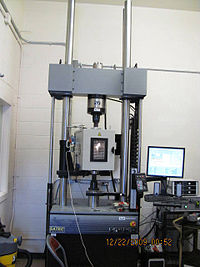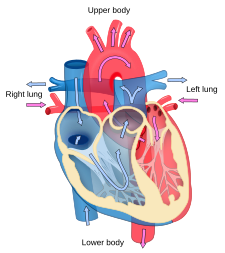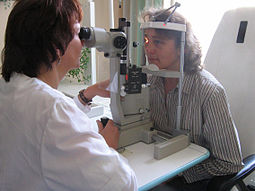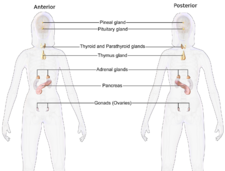Portal:Science
Portal maintenance status: (January 2019)
|
Introduction
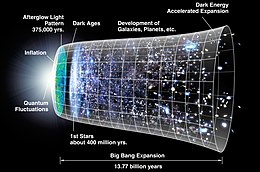
Science (from the Latin word scientia, meaning "knowledge") is a systematic enterprise that builds and organizes knowledge in the form of testable explanations and predictions about the universe.
The earliest roots of science can be traced to Ancient Egypt and Mesopotamia in around 3500 to 3000 BCE. Their contributions to mathematics, astronomy, and medicine entered and shaped Greek natural philosophy of classical antiquity, whereby formal attempts were made to explain events of the physical world based on natural causes. After the fall of the Western Roman Empire, knowledge of Greek conceptions of the world deteriorated in Western Europe during the early centuries (400 to 1000 CE) of the Middle Ages but was preserved in the Muslim world during the Islamic Golden Age. The recovery and assimilation of Greek works and Islamic inquiries into Western Europe from the 10th to 13th century revived natural philosophy, which was later transformed by the Scientific Revolution that began in the 16th century as new ideas and discoveries departed from previous Greek conceptions and traditions. The scientific method soon played a greater role in knowledge creation and it was not until the 19th century that many of the institutional and professional features of science began to take shape.
Main branches of science
Natural science is a branch of science concerned with the description, prediction, and understanding of natural phenomena, based on empirical evidence from observation and experimentation. Mechanisms such as peer review and repeatability of findings are used to try to ensure the validity of scientific advances.
Natural science can be divided into two main branches: life science (or biological science) and physical science. Physical science is subdivided into branches, including physics, chemistry, astronomy and earth science. These branches of natural science may be further divided into more specialized branches (also known as fields). Read more...- Applied science is the application of existing scientific knowledge to practical applications, like technology or inventions.
Within natural science, disciplines that are basic science, also called pure science, develop basic information to
predict and perhaps explain and understand phenomena in the natural world. Applied science is the use of scientific processes and knowledge as the means to achieve a particular practical or useful result. This includes a broad range of applied science related fields from engineering, business, medicine to early childhood education. Read more... - Formal sciences are formal language disciplines concerned with formal systems, such as logic, mathematics, statistics, theoretical computer science, robotics, information theory, game theory, systems theory, decision theory, and theoretical linguistics. Whereas the natural sciences and social sciences seek to characterize physical systems and social systems, respectively, using empirical methods, the formal sciences are language tools concerned with characterizing abstract structures described by sign systems. The formal sciences aid the natural and social sciences by providing information about the structures the latter use to describe the world, and what inferences may be made about them. Read more...
- Social science is a category of academic disciplines, concerned with society and the relationships among individuals within a society. Social science as a whole has many branches. These social sciences include, but are not limited to: anthropology, archaeology, communication studies, economics, history, human geography, jurisprudence, linguistics, political science, psychology, public health, and sociology. The term is also sometimes used to refer specifically to the field of sociology, the original "science of society", established in the 19th century. For a more detailed list of sub-disciplines within the social sciences see: Outline of social science.
Positivist social scientists use methods resembling those of the natural sciences as tools for understanding society, and so define science in its stricter modern sense. Interpretivist social scientists, by contrast, may use social critique or symbolic interpretation rather than constructing empirically falsifiable theories, and thus treat science in its broader sense. In modern academic practice, researchers are often eclectic, using multiple methodologies (for instance, by combining both quantitative and qualitative research). The term "social research" has also acquired a degree of autonomy as practitioners from various disciplines share in its aims and methods. Read more...
Selected branches of natural science
- Computational chemistry is a branch of chemistry that uses computer simulation to assist in solving chemical problems. It uses methods of theoretical chemistry, incorporated into efficient computer programs, to calculate the structures and properties of molecules and solids. It is necessary because, apart from relatively recent results concerning the hydrogen molecular ion (dihydrogen cation, see references therein for more details), the quantum many-body problem cannot be solved analytically, much less in closed form. While computational results normally complement the information obtained by chemical experiments, it can in some cases predict hitherto unobserved chemical phenomena. It is widely used in the design of new drugs and materials.
Examples of such properties are structure (i.e., the expected positions of the constituent atoms), absolute and relative (interaction) energies, electronic charge density distributions, dipoles and higher multipole moments, vibrational frequencies, reactivity, or other spectroscopic quantities, and cross sections for collision with other particles. Read more...
Cetology (from Greek κῆτος, kētos, "whale"; and -λογία, -logia) or Whalelore is the branch of marine mammal science that studies the approximately eighty species of whales, dolphins, and porpoise in the scientific order Cetacea. Cetologists, or those who practice cetology, seek to understand and explain cetacean evolution, distribution, morphology, behavior, community dynamics, and other topics. Read more... Eye of Hurricane Isabel from the International Space Station, September 15, 2003.
Eye of Hurricane Isabel from the International Space Station, September 15, 2003.
The following outline is provided as an overview of and topical guide to meteorology:
Meteorology – interdisciplinary scientific study of the atmosphere which explains and forecasts weather events. Meteorology has application in many diverse fields such as the military, energy production, transport, agriculture and construction. Read more...- Mechanochemistry or mechanical chemistry is the coupling of mechanical and chemical phenomena on a molecular scale and includes mechanical breakage, chemical behaviour of mechanically stressed solids (e.g., stress-corrosion cracking or enhanced oxidation), tribology, polymer degradation under shear, cavitation-related phenomena (e.g., sonochemistry and sonoluminescence), shock wave chemistry and physics, and even the burgeoning field of molecular machines. Mechanochemistry can be seen as an interface between chemistry and mechanical engineering. It is possible to synthesize chemical products by using only mechanical action. The mechanisms of mechanochemical transformations are often complex and different from usual thermal or photochemical mechanisms. The method of ball milling is a widely used process in which mechanical force is used to achieve chemical processing and transformations. The special issue of Chemical Society Review (vol. 42, 2013, Issue 18) is dedicated to the theme of mechanochemistry. Fundamentals and applications ranging from nano materials to technology have been reviewed. The mechanochemical approach has been used to synthesize metallic nanoparticles, catalysts, magnets, γ‐graphyne, metal iodates, nickel–vanadium carbide and molybdenum–vanadium carbide nanocomposite powders
Mechanochemistry is radically different from the traditional way of dissolving, heating and stirring chemicals in a solution. Because it eliminates the need for many solvents, mechanochemistry could help make many chemical processes used by industry more environmentally friendly. For example, the mechanochemical process has been used as an environmentally preferable way to synthesize pharmaceutically-attractive phenol hydrazones. Read more... - Developmental biology is the study of the process by which animals and plants grow and develop. Developmental biology also encompasses the biology of regeneration, asexual reproduction, metamorphosis, and the growth and differentiation of stem cells in the adult organism.
In the late 20th century, the discipline largely transformed into evolutionary developmental biology. Read more... 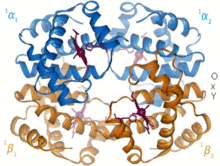 Hemoglobin, the oxygen transporting protein found in red blood cells
Hemoglobin, the oxygen transporting protein found in red blood cells
Structural biology is a branch of molecular biology, biochemistry, and biophysics concerned with the molecular structure of biological macromolecules (especially proteins, made up of amino acids, and RNA or DNA, made up of nucleotides), how they acquire the structures they have, and how alterations in their structures affect their function. This subject is of great interest to biologists because macromolecules carry out most of the functions of cells, and it is only by coiling into specific three-dimensional shapes that they are able to perform these functions. This architecture, the "tertiary structure" of molecules, depends in a complicated way on each molecule's basic composition, or "primary structure."
Biomolecules are too small to see in detail even with the most advanced light microscopes. The methods that structural biologists use to determine their structures generally involve measurements on vast numbers of identical molecules at the same time. These methods include:- Mass spectrometry
- Macromolecular crystallography
- Proteolysis
- Nuclear magnetic resonance spectroscopy of proteins (NMR)
- Electron paramagnetic resonance (EPR)
- Cryo-electron microscopy (cryo-EM)
- Multiangle light scattering
- Small angle scattering
- Ultrafast laser spectroscopy
- Dual-polarization interferometry and circular dichroism
Most often researchers use them to study the "native states" of macromolecules. But variations on these methods are also used to watch nascent or denatured molecules assume or reassume their native states. See protein folding. Read more...- Hydrogeology (hydro- meaning water, and -geology meaning the study of the Earth) is the area of geology that deals with the distribution and movement of groundwater in the soil and rocks of the Earth's crust (commonly in aquifers). The terms groundwater hydrology, geohydrology, and hydrogeology are often used interchangeably.
Groundwater engineering, another name for hydrogeology, is a branch of engineering which is concerned with groundwater movement and design of wells, pumps, and drains. The main concerns in groundwater engineering include groundwater contamination, conservation of supplies, and water quality. Read more...  Planetary geologist and NASA astronaut Harrison "Jack" Schmitt collecting lunar samples during the Apollo 17 mission in early-December 1972
Planetary geologist and NASA astronaut Harrison "Jack" Schmitt collecting lunar samples during the Apollo 17 mission in early-December 1972
Planetary geology, alternatively known as astrogeology or exogeology, is a planetary science discipline concerned with the geology of the celestial bodies such as the planets and their moons, asteroids, comets, and meteorites. Although the geo- prefix typically indicates topics of or relating to the Earth, planetary geology is named as such for historical and convenience reasons; applying geological science to other planetary bodies. Due to the types of investigations involved, it is also closely linked with Earth-based geology.
Planetary geology includes such topics as determining the internal structure of the terrestrial planets, and also looks at planetary volcanism and surface processes such as impact craters, fluvial and aeolian processes. The structures of the giant planets and their moons are also examined, as is the make-up of the minor bodies of the Solar System, such as asteroids, the Kuiper Belt, and comets. Read more...- The following outline is provided as an overview of and topical guide to ecology:
Ecology – scientific study of the distribution and abundance of living organisms and how the distribution and abundance are affected by interactions between the organisms and their environment. The environment of an organism includes both physical properties, which can be described as the sum of local abiotic factors such as solar insolation, climate and geology, as well as the other organisms that share its habitat. Also called ecological science. Read more...
Electromagnetism is a branch of physics involving the study of the electromagnetic force, a type of physical interaction that occurs between electrically charged particles. The electromagnetic force usually exhibits electromagnetic fields such as electric fields, magnetic fields, and light, and is one of the four fundamental interactions (commonly called forces) in nature. The other three fundamental interactions are the strong interaction, the weak interaction, and gravitation. At high energy the weak force and electromagnetic force are unified as a single electroweak force.
Electromagnetic phenomena are defined in terms of the electromagnetic force, sometimes called the Lorentz force, which includes both electricity and magnetism as different manifestations of the same phenomenon. The electromagnetic force plays a major role in determining the internal properties of most objects encountered in daily life. Ordinary matter takes its form as a result of intermolecular forces between individual atoms and molecules in matter, and is a manifestation of the electromagnetic force. Electrons are bound by the electromagnetic force to atomic nuclei, and their orbital shapes and their influence on nearby atoms with their electrons is described by quantum mechanics. The electromagnetic force governs all chemical processes, which arise from interactions between the electrons of neighboring atoms. Read more...- Mathematical and theoretical biology is a branch of biology which employs theoretical analysis, mathematical models and abstractions of the living organisms to investigate the principles that govern the structure, development and behavior of the systems, as opposed to experimental biology which deals with the conduction of experiments to prove and validate the scientific theories. The field is sometimes called mathematical biology or biomathematics to stress the mathematical side, or theoretical biology to stress the biological side. Theoretical biology focuses more on the development of theoretical principles for biology while mathematical biology focuses on the use of mathematical tools to study biological systems, even though the two terms are sometimes interchanged.
Mathematical biology aims at the mathematical representation and modeling of biological processes, using techniques and tools of applied mathematics. It has both theoretical and practical applications in biological, biomedical and biotechnology research. Describing systems in a quantitative manner means their behavior can be better simulated, and hence properties can be predicted that might not be evident to the experimenter. This requires precise mathematical models. Read more...  Oil painting depicting Claude Bernard, the father of modern physiology, with his pupils
Oil painting depicting Claude Bernard, the father of modern physiology, with his pupils
Physiology (/ˌfɪziˈɒlədʒi/; from Ancient Greek φύσις (physis), meaning 'nature, origin', and -λογία (-logia), meaning 'study of') is the scientific study of the functions and mechanisms which work within a living system.
As a sub-discipline of biology, the focus of physiology is on how organisms, organ systems, organs, cells, and biomolecules carry out the chemical and physical functions that exist in a living system. Read more...- Mathematical chemistry is the area of research engaged in novel applications of mathematics to chemistry; it concerns itself principally with the mathematical modeling of chemical phenomena. Mathematical chemistry has also sometimes been called computer chemistry, but should not be confused with computational chemistry.
Major areas of research in mathematical chemistry include chemical graph theory, which deals with topology such as the mathematical study of isomerism and the development of topological descriptors or indices which find application in quantitative structure-property relationships; and chemical aspects of group theory, which finds applications in stereochemistry and quantum chemistry. Read more...  A volcanologist sampling lava using a rock hammer and a bucket of water
A volcanologist sampling lava using a rock hammer and a bucket of water
Volcanology (also spelled vulcanology) is the study of volcanoes, lava, magma, and related geological, geophysical and geochemical phenomena. The term volcanology is derived from the Latin word vulcan. Vulcan was the ancient Roman god of fire.
A volcanologist is a geologist who studies the eruptive activity and formation of volcanoes, and their current and historic eruptions. Volcanologists frequently visit volcanoes, especially active ones, to observe volcanic eruptions, collect eruptive products including tephra (such as ash or pumice), rock and lava samples. One major focus of enquiry is the prediction of eruptions; there is currently no accurate way to do this, but predicting eruptions, like predicting earthquakes, could save many lives. Read more...- Agrophysics is a branch of science bordering on agronomy and physics,
whose objects of study are the agroecosystem - the biological objects, biotope and biocoenosis affected by human activity, studied and described using the methods of physical sciences. Using the achievements of the exact sciences to solve major problems in agriculture, agrophysics involves the study of materials and processes occurring in the production and processing of agricultural crops, with particular emphasis on the condition of the environment and the quality of farming materials and food production.
Agrophysics is closely related to biophysics, but is restricted to the biology of the plants, animals, soil and an atmosphere involved in agricultural activities and biodiversity. It is different from biophysics in having the necessity of taking into account the specific features of biotope and biocoenosis, which involves the knowledge of nutritional science and agroecology, agricultural technology, biotechnology, genetics etc. Read more... - Plant pathology (also phytopathology) is the scientific study of diseases in plants caused by pathogens (infectious organisms) and environmental conditions (physiological factors). Organisms that cause infectious disease include fungi, oomycetes, bacteria, viruses, viroids, virus-like organisms, phytoplasmas, protozoa, nematodes and parasitic plants. Not included are ectoparasites like insects, mites, vertebrate, or other pests that affect plant health by eating of plant tissues. Plant pathology also involves the study of pathogen identification, disease etiology, disease cycles, economic impact, plant disease epidemiology, plant disease resistance, how plant diseases affect humans and animals, pathosystem genetics, and management of plant diseases. Read more...
Microbiology (from Greek μῑκρος, mīkros, "small"; βίος, bios, "life"; and -λογία, -logia) is the study of microorganisms, those being unicellular (single cell), multicellular (cell colony), or acellular (lacking cells). Microbiology encompasses numerous sub-disciplines including virology, parasitology, mycology and bacteriology.
Eukaryotic microorganisms possess membrane-bound cell organelles and include fungi and protists, whereas prokaryotic organisms—all of which are microorganisms—are conventionally classified as lacking membrane-bound organelles and include Bacteria and Archaea. Microbiologists traditionally relied on culture, staining, and microscopy. However, less than 1% of the microorganisms present in common environments can be cultured in isolation using current means. Microbiologists often rely on molecular biology tools such as DNA sequence based identification, for example 16s rRNA gene sequence used for bacteria identification. Read more...- The following outline is provided as an overview of and topical guide to chemistry:
Chemistry – science of atomic matter (matter that is composed of chemical elements), especially its chemical reactions, but also including its properties, structure, composition, behavior, and changes as they relate the chemical reactions. Chemistry is centrally concerned with atoms and their interactions with other atoms, and particularly with the properties of chemical bonds. Read more...  STM image of a quinacridone adsorbate. The self-assembled supramolecular chains of the organic semiconductor are adsorbed on a graphite surface.
STM image of a quinacridone adsorbate. The self-assembled supramolecular chains of the organic semiconductor are adsorbed on a graphite surface.
Surface science is the study of physical and chemical phenomena that occur at the interface of two phases, including solid–liquid interfaces, solid–gas interfaces, solid–vacuum interfaces, and liquid–gas interfaces. It includes the fields of surface chemistry and surface physics. Some related practical applications are classed as surface engineering. The science encompasses concepts such as heterogeneous catalysis, semiconductor device fabrication, fuel cells, self-assembled monolayers, and adhesives. Surface science is closely related to interface and colloid science. Interfacial chemistry and physics are common subjects for both. The methods are different. In addition, interface and colloid science studies macroscopic phenomena that occur in heterogeneous systems due to peculiarities of interfaces. Read more...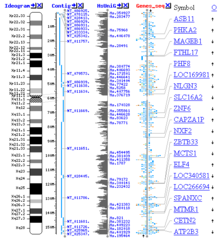 Map of the human X chromosome (from the National Center for Biotechnology Information website).
Map of the human X chromosome (from the National Center for Biotechnology Information website).
Bioinformatics /ˌbaɪ.oʊˌɪnfərˈmætɪks/ ( listen) is an interdisciplinary field that develops methods and software tools for understanding biological data. As an interdisciplinary field of science, bioinformatics combines biology, computer science, information engineering, mathematics and statistics to analyze and interpret biological data. Bioinformatics has been used for in silico analyses of biological queries using mathematical and statistical techniques.
listen) is an interdisciplinary field that develops methods and software tools for understanding biological data. As an interdisciplinary field of science, bioinformatics combines biology, computer science, information engineering, mathematics and statistics to analyze and interpret biological data. Bioinformatics has been used for in silico analyses of biological queries using mathematical and statistical techniques.
Bioinformatics is both an umbrella term for the body of biological studies that use computer programming as part of their methodology, as well as a reference to specific analysis "pipelines" that are repeatedly used, particularly in the field of genomics. Common uses of bioinformatics include the identification of candidates genes and single nucleotide polymorphisms (SNPs). Often, such identification is made with the aim of better understanding the genetic basis of disease, unique adaptations, desirable properties (esp. in agricultural species), or differences between populations. In a less formal way, bioinformatics also tries to understand the organisational principles within nucleic acid and protein sequences, called proteomics. Read more...- Zoology (/zuˈɒlədʒi,
zoʊ-/ ) is the branch of biology that studies the animal kingdom, including the structure, embryology, evolution, classification, habits, and distribution of all animals, both living and extinct, and how they interact with their ecosystems. The term is derived from Ancient Greek ζῷον, zōion, i.e. "animal" and λόγος, logos, i.e. "knowledge, study". Read more...
Kinesiology is the scientific study of human or non-human body movement. Kinesiology addresses physiological, biomechanical, and psychological dynamic principles and mechanisms of movement. Applications of kinesiology to human health (i.e., human kinesiology) include biomechanics and orthopedics; strength and conditioning; sport psychology; methods of rehabilitation, such as physical and occupational therapy; and sport and exercise. Studies of human and animal motion include measures from motion tracking systems, electrophysiology of muscle and brain activity, various methods for monitoring physiological function, and other behavioral and cognitive research techniques.
The word comes from the Greek κίνησις kínēsis, "movement" (itself from κινεῖν kineîn, "to move"), and -λογία -logia, "study". Read more....jpg/300px-Carnot_engine_(hot_body_-_working_body_-_cold_body).jpg) Annotated color version of the original 1824 Carnot heat engine showing the hot body (boiler), working body (system, steam), and cold body (water), the letters labeled according to the stopping points in Carnot cycle.
Annotated color version of the original 1824 Carnot heat engine showing the hot body (boiler), working body (system, steam), and cold body (water), the letters labeled according to the stopping points in Carnot cycle.
Thermodynamics is the branch of physics that has to do with heat and temperature and their relation to energy and work. The behavior of these quantities is governed by the four laws of thermodynamics, irrespective of the composition or specific properties of the material or system in question. The laws of thermodynamics are explained in terms of microscopic constituents by statistical mechanics. Thermodynamics applies to a wide variety of topics in science and engineering, especially physical chemistry, chemical engineering and mechanical engineering.
Historically, thermodynamics developed out of a desire to increase the efficiency of early steam engines, particularly through the work of French physicist Nicolas Léonard Sadi Carnot (1824) who believed that engine efficiency was the key that could help France win the Napoleonic Wars. Scots-Irish physicist Lord Kelvin was the first to formulate a concise definition of thermodynamics in 1854 which stated, "Thermo-dynamics is the subject of the relation of heat to forces acting between contiguous parts of bodies, and the relation of heat to electrical agency." Read more...- Econophysics is an interdisciplinary research field, applying theories and methods originally developed by physicists in order to solve problems in economics, usually those including uncertainty or stochastic processes and nonlinear dynamics. Some of its application to the study of financial markets has also been termed statistical finance referring to its roots in statistical physics. Read more...
- The following outline is provided as an overview of and topical guide to biochemistry:
Biochemistry – study of chemical processes in living organisms, including living matter. Biochemistry governs all living organisms and living processes. Read more... - Geoinformatics is the science and the technology which develops and uses information science infrastructure to address the problems of geography, cartography, geosciences and related branches of science and engineering. Read more...
 Analysis of white light by dispersing it with a prism is an example of spectroscopy.
Analysis of white light by dispersing it with a prism is an example of spectroscopy.
Spectroscopy /spɛkˈtrɒskəpi/ is the study of the interaction between matter and electromagnetic radiation. Historically, spectroscopy originated through the study of visible light dispersed according to its wavelength, by a prism. Later the concept was expanded greatly to include any interaction with radiative energy as a function of its wavelength or frequency, predominantly in the electromagnetic spectrum, though matter waves and acoustic waves can also be considered forms of radiative energy; recently, with tremendous difficulty, even gravitational waves have been associated with a spectral signature in the context of LIGO and laser interferometry. Spectroscopic data are often represented by an emission spectrum, a plot of the response of interest as a function of wavelength or frequency.
Spectroscopy, primarily in the electromagnetic spectrum, is a fundamental exploratory tool in the fields of physics, chemistry, and astronomy, allowing the composition and structure of matter to be investigated at molecular scale, macro scale, and over astronomical distances. Important applications arise from biomedical spectroscopy in the areas of tissue analysis and medical imaging. Read more...
Seismology ( /saɪzˈmɒlədʒi/; from Ancient Greek σεισμός (seismós) meaning "earthquake" and -λογία (-logía) meaning "study of") is the scientific study of earthquakes and the propagation of elastic waves through the Earth or through other planet-like bodies. The field also includes studies of earthquake environmental effects such as tsunamis as well as diverse seismic sources such as volcanic, tectonic, oceanic, atmospheric, and artificial processes such as explosions. A related field that uses geology to infer information regarding past earthquakes is paleoseismology. A recording of earth motion as a function of time is called a seismogram. A seismologist is a scientist who does research in seismology. Read more...- Femtochemistry is the area of physical chemistry that studies chemical reactions on extremely short timescales (approximately 10−15 seconds or one femtosecond, hence the name) in order to study the very act of atoms within molecules (reactants) rearranging themselves to form new molecules (products). In 1999, Ahmed Hassan Zewail received the Nobel Prize in Chemistry for his pioneering work in this field showing that it is possible to see how atoms in a molecule move during a chemical reaction with flashes of laser light.
Application of femtochemistry in biological studies has also helped to elucidate the conformational dynamics of stem-loop RNA structures. Read more...  The Hubble eXtreme Deep Field (XDF) was completed in September 2012 and shows the farthest galaxies ever photographed. Except for the few stars in the foreground (which are bright and easily recognizable because only they have diffraction spikes), every speck of light in the photo is an individual galaxy, some of them as old as 13.2 billion years; the observable universe is estimated to contain more than 2 trillion galaxies.
The Hubble eXtreme Deep Field (XDF) was completed in September 2012 and shows the farthest galaxies ever photographed. Except for the few stars in the foreground (which are bright and easily recognizable because only they have diffraction spikes), every speck of light in the photo is an individual galaxy, some of them as old as 13.2 billion years; the observable universe is estimated to contain more than 2 trillion galaxies.
Cosmology (from the Greek κόσμος, kosmos "world" and -λογία, -logia "study of") is a branch of astronomy concerned with the studies of the origin and evolution of the universe, from the Big Bang to today and on into the future. It is the scientific study of the origin, evolution, and eventual fate of the universe. Physical cosmology is the scientific study of the universe's origin, its large-scale structures and dynamics, and its ultimate fate, as well as the laws of science that govern these areas.
The term cosmology was first used in English in 1656 in Thomas Blount's Glossographia, and in 1731 taken up in Latin by German philosopher Christian Wolff, in Cosmologia Generalis. Read more...
Lepidopterology (from Ancient Greek λεπίδος (scale) and πτερόν (wing); and -λογία -logia.), is a branch of entomology concerning the scientific study of moths and the three superfamilies of butterflies. Someone that studies in this field is a lepidopterist or, archaically, an aurelian. Read more...
The following outline is provided as an overview of and topical guide to Earth science:
Earth science – all-embracing term for the sciences related to the planet Earth. It is also known as geoscience, the geosciences or the Earth sciences, and is arguably a special case in planetary science, the Earth being the only known life-bearing planet. Read more...- Population genetics is a subfield of genetics that deals with genetic differences within and between populations, and is a part of evolutionary biology. Studies in this branch of biology examine such phenomena as adaptation, speciation, and population structure.
Population genetics was a vital ingredient in the emergence of the modern evolutionary synthesis. Its primary founders were Sewall Wright, J. B. S. Haldane and Ronald Fisher, who also laid the foundations for the related discipline of quantitative genetics. Traditionally a highly mathematical discipline, modern population genetics encompasses theoretical, lab, and field work. Population genetic models are used both for statistical inference from DNA sequence data and for proof/disproof of concept. Read more... - Neurochemistry is the study of neurochemicals, including neurotransmitters and other molecules such as psychopharmaceuticals and neuropeptides, that influence the function of neurons. This field within neuroscience examines how neurochemicals influence the operation of neurons, synapses, and neural networks. Neurochemists analyze the biochemistry and molecular biology of organic compounds in the nervous system, and their roles in such neural processes as cortical plasticity, neurogenesis, and neural differentiation. Read more...
Galactic astronomy is the study of the Milky Way galaxy and all its contents. This is in contrast to extragalactic astronomy, which is the study of everything outside our galaxy, including all other galaxies.
Galactic astronomy should not be confused with galaxy formation and evolution, which is the general study of galaxies, their formation, structure, components, dynamics, interactions, and the range of forms they take. Read more...- Environmental soil science is the study of the interaction of humans with the pedosphere as well as critical aspects of the biosphere, the lithosphere, the hydrosphere, and the atmosphere. Environmental soil science addresses both the fundamental and applied aspects of the field including: buffers and surface water quality, vadose zone functions, septic drain field site assessment and function, land treatment of wastewater, stormwater, erosion control, soil contamination with metals and pesticides, remediation of contaminated soils, restoration of wetlands, soil degradation, nutrient management, movement of viruses and bacteria in soils and waters, bioremediation, application of molecular biology and genetic engineering to development of soil microbes that can degrade hazardous pollutants, land use, global warming, acid rain, and the study of anthropogenic soils, such as terra preta. Much of the research done in environmental soil science is produced through the use of models. Read more...
 Wavefunctions of the electron in a hydrogen atom at different energy levels. Quantum mechanics cannot predict the exact location of a particle in space, only the probability of finding it at different locations. The brighter areas represent a higher probability of finding the electron.
Wavefunctions of the electron in a hydrogen atom at different energy levels. Quantum mechanics cannot predict the exact location of a particle in space, only the probability of finding it at different locations. The brighter areas represent a higher probability of finding the electron.
Quantum mechanics (QM; also known as quantum physics, quantum theory, the wave mechanical model, or matrix mechanics), including quantum field theory, is a fundamental theory in physics which describes nature at the smallest scales of energy levels of atoms and subatomic particles.
Classical physics, the physics existing before quantum mechanics, describes nature at ordinary (macroscopic) scale. Most theories in classical physics can be derived from quantum mechanics as an approximation valid at large (macroscopic) scale.
Quantum mechanics differs from classical physics in that energy, momentum, angular momentum and other quantities of a bound system are restricted to discrete values (quantization); objects have characteristics of both particles and waves (wave-particle duality); and there are limits to the precision with which quantities can be measured (uncertainty principle). Read more...
Orbital mechanics or astrodynamics is the application of ballistics and celestial mechanics to the practical problems concerning the motion of rockets and other spacecraft. The motion of these objects is usually calculated from Newton's laws of motion and law of universal gravitation. It is a core discipline within space-mission design and control.
Celestial mechanics treats more broadly the orbital dynamics of systems under the influence of gravity, including both spacecraft and natural astronomical bodies such as star systems, planets, moons, and comets. Orbital mechanics focuses on spacecraft trajectories, including orbital maneuvers, orbital plane changes, and interplanetary transfers, and is used by mission planners to predict the results of propulsive maneuvers. General relativity is a more exact theory than Newton's laws for calculating orbits, and is sometimes necessary for greater accuracy or in high-gravity situations (e.g. orbits near the Sun). Read more... 71 percent of the Earth's surface is covered by ocean, the home to marine life. Oceans average nearly four kilometres in depth and are fringed with coastlines that run for 360,000 kilometres.
71 percent of the Earth's surface is covered by ocean, the home to marine life. Oceans average nearly four kilometres in depth and are fringed with coastlines that run for 360,000 kilometres.
Marine biology is the scientific study of marine life, organisms in the sea. Given that in biology many phyla, families and genera have some species that live in the sea and others that live on land, marine biology classifies species based on the environment rather than on taxonomy.
A large proportion of all life on Earth lives in the ocean. The exact size of this large proportion is unknown, since many ocean species are still to be discovered. The ocean is a complex three-dimensional world covering approximately 71% of the Earth's surface. The habitats studied in marine biology include everything from the tiny layers of surface water in which organisms and abiotic items may be trapped in surface tension between the ocean and atmosphere, to the depths of the oceanic trenches, sometimes 10,000 meters or more beneath the surface of the ocean. Specific habitats include coral reefs, kelp forests, seagrass meadows, the surrounds of seamounts and thermal vents, tidepools, muddy, sandy and rocky bottoms, and the open ocean (pelagic) zone, where solid objects are rare and the surface of the water is the only visible boundary. The organisms studied range from microscopic phytoplankton and zooplankton to huge cetaceans (whales) 25–32 meters (82–105 feet) in length. Marine ecology is the study of how marine organisms interact with each other and the environment. Read more...
Pathology (from the Ancient Greek roots of pathos (πάθος), meaning "experience" or "suffering" and -logia (-λογία), "study of") is concerned mainly with the causal study of disease.
The word pathology itself may be used broadly to refer to the study of disease in general, incorporating a wide range of bioscience research fields and medical practices. However, when used in the context of modern medical treatment, the term is often used in a more narrow fashion to refer to processes and tests which fall within the contemporary medical field of "general pathology," an area which includes a number of distinct but inter-related medical specialties that diagnose disease, mostly through analysis of tissue, cell, and body fluid samples. Idiomatically, "a pathology" may also refer to the predicted or actual progression of particular diseases (as in the statement "the many different forms of cancer have diverse pathologies"), and the affix path is sometimes used to indicate a state of disease in cases of both physical ailment (as in cardiomyopathy) and psychological conditions (such as psychopathy). A physician practicing pathology is called a pathologist. Read more...
Oceanography (compound of the Greek words ὠκεανός meaning "ocean" and γράφω meaning "write"), also known as oceanology, is the study of the physical and biological aspects of the ocean. It is an Earth science, which covers a wide range of topics, including ecosystem dynamics; ocean currents, waves, and geophysical fluid dynamics; plate tectonics and the geology of the sea floor; and fluxes of various chemical substances and physical properties within the ocean and across its boundaries. These diverse topics reflect multiple disciplines that oceanographers blend to further knowledge of the world ocean and understanding of processes within: astronomy, biology, chemistry, climatology, geography, geology, hydrology, meteorology and physics. Paleoceanography studies the history of the oceans in the geologic past. Read more...- Atmospheric physics is the application of physics to the study of the atmosphere. Atmospheric physicists attempt to model Earth's atmosphere and the atmospheres of the other planets using fluid flow equations, chemical models, radiation budget, and energy transfer processes in the atmosphere (as well as how these tie into other systems such as the oceans). In order to model weather systems, atmospheric physicists employ elements of scattering theory, wave propagation models, cloud physics, statistical mechanics and spatial statistics which are highly mathematical and related to physics. It has close links to meteorology and climatology and also covers the design and construction of instruments for studying the atmosphere and the interpretation of the data they provide, including remote sensing instruments. At the dawn of the space age and the introduction of sounding rockets, aeronomy became a subdiscipline concerning the upper layers of the atmosphere, where dissociation and ionization are important. Read more...
 Nucleic acids may not be the only biomolecules in the Universe capable of coding for life processes.
Nucleic acids may not be the only biomolecules in the Universe capable of coding for life processes.
Astrobiology is an interdisciplinary scientific field concerned with the origins, early evolution, distribution, and future of life in the universe. Astrobiology considers the question of whether extraterrestrial life exists, and how humans can detect it if it does. The term exobiology is similar.
Astrobiology makes use of molecular biology, biophysics, biochemistry, chemistry, astronomy, physical cosmology, exoplanetology and geology to investigate the possibility of life on other worlds and help recognize biospheres that might be different from that on Earth. The origin and early evolution of life is an inseparable part of the discipline of astrobiology. Astrobiology concerns itself with interpretation of existing scientific data, and although speculation is entertained to give context, astrobiology concerns itself primarily with hypotheses that fit firmly into existing scientific theories. Read more... The human population is growing at a logistic rate and has been affecting the populations of other species in return. Chemical pollution, deforestation, and population are very big problems. Irrigation are examples of means by which humans may influence the population ecology of other species. As the human population increases, its effect on the populations of other species may also increase.
The human population is growing at a logistic rate and has been affecting the populations of other species in return. Chemical pollution, deforestation, and population are very big problems. Irrigation are examples of means by which humans may influence the population ecology of other species. As the human population increases, its effect on the populations of other species may also increase.
Population ecology is a sub-field of ecology that deals with the dynamics of species populations and how these populations interact with the environment. It is the study of how the population sizes of species change over time and space. The term population ecology is often used interchangeably with population biology or population dynamics.
The development of population ecology owes much to demography and actuarial life tables. Population ecology is important in conservation biology, especially in the development of population viability analysis (PVA) which makes it possible to predict the long-term probability of a species persisting in a given habitat patch. Although population ecology is a subfield of biology, it provides interesting problems for mathematicians and statisticians who work in population dynamics. Read more...- Agricultural chemistry is the study of both chemistry and biochemistry which are important in agricultural production, the processing of raw products into foods and beverages, and in environmental monitoring and remediation. These studies emphasize the relationships between plants, animals and bacteria and their environment.
The science of chemical compositions and changes involved in the production, protection, and use of crops and livestock. As a basic science, it embraces, in addition to test-tube chemistry, all the life processes through which humans obtain food and fiber for themselves and feed for their animals. As an applied science or technology, it is directed toward control of those processes to increase yields, improve quality, and reduce costs. One important branch of it, chemurgy, is concerned chiefly with utilization of agricultural products as chemical raw materials. Etc. Read more... - Immunochemistry is a branch of chemistry that involves the study of the molecular mechanisms underlying the function of the immune system, especially the nature of antibodies, antigens and their interactions.
Various methods in immunochemistry have been developed and refined, and been used in scientific study, from virology to molecular evolution. Read more... - Building biology (or Baubiologie) is a field of building science investigating the indoor living environment for a variety of irritants. Practitioners study how the environment of residential, commercial and public buildings can affect the health of the occupants, producing a restful or stressful environment. Important areas of building biology are building materials and processes, electromagnetic fields (EMFs) and radiation (EMR) and indoor air quality (IAQ).
There are 25 principles of building biology, which govern the decision making of building biologists[clarify]. Read more...
The following outline is provided as an overview of and topical guide to geography:
Geography – study of earth and its people. Read more... 71 percent of the Earth's surface is covered by ocean, the home to marine life. Oceans average nearly four kilometres in depth and are fringed with coastlines that run for 360,000 kilometres.
71 percent of the Earth's surface is covered by ocean, the home to marine life. Oceans average nearly four kilometres in depth and are fringed with coastlines that run for 360,000 kilometres.
Marine biology is the scientific study of marine life, organisms in the sea. Given that in biology many phyla, families and genera have some species that live in the sea and others that live on land, marine biology classifies species based on the environment rather than on taxonomy.
A large proportion of all life on Earth lives in the ocean. The exact size of this large proportion is unknown, since many ocean species are still to be discovered. The ocean is a complex three-dimensional world covering approximately 71% of the Earth's surface. The habitats studied in marine biology include everything from the tiny layers of surface water in which organisms and abiotic items may be trapped in surface tension between the ocean and atmosphere, to the depths of the oceanic trenches, sometimes 10,000 meters or more beneath the surface of the ocean. Specific habitats include coral reefs, kelp forests, seagrass meadows, the surrounds of seamounts and thermal vents, tidepools, muddy, sandy and rocky bottoms, and the open ocean (pelagic) zone, where solid objects are rare and the surface of the water is the only visible boundary. The organisms studied range from microscopic phytoplankton and zooplankton to huge cetaceans (whales) 25–32 meters (82–105 feet) in length. Marine ecology is the study of how marine organisms interact with each other and the environment. Read more...
Selected branches of formal science
 Nucleic acids may not be the only biomolecules in the Universe capable of coding for life processes.
Nucleic acids may not be the only biomolecules in the Universe capable of coding for life processes.
Astrobiology is an interdisciplinary scientific field concerned with the origins, early evolution, distribution, and future of life in the universe. Astrobiology considers the question of whether extraterrestrial life exists, and how humans can detect it if it does. The term exobiology is similar.
Astrobiology makes use of molecular biology, biophysics, biochemistry, chemistry, astronomy, physical cosmology, exoplanetology and geology to investigate the possibility of life on other worlds and help recognize biospheres that might be different from that on Earth. The origin and early evolution of life is an inseparable part of the discipline of astrobiology. Astrobiology concerns itself with interpretation of existing scientific data, and although speculation is entertained to give context, astrobiology concerns itself primarily with hypotheses that fit firmly into existing scientific theories. Read more...- Evolutionary psychology is a theoretical approach in the social and natural sciences that examines psychological structure from a modern evolutionary perspective. It seeks to identify which human psychological traits are evolved adaptations – that is, the functional products of natural selection or sexual selection in human evolution. Adaptationist thinking about physiological mechanisms, such as the heart, lungs, and immune system, is common in evolutionary biology. Some evolutionary psychologists apply the same thinking to psychology, arguing that the modularity of mind is similar to that of the body and with different modular adaptations serving different functions. Evolutionary psychologists argue that much of human behavior is the output of psychological adaptations that evolved to solve recurrent problems in human ancestral environments.
Evolutionary psychology is not simply a subdiscipline of psychology but its evolutionary theory can provide a foundational, metatheoretical framework that integrates the entire field of psychology in the same way evolutionary biology has for biology. Read more... - Archaeology is the study of human activity in the past, primarily through the recovery and analysis of the material culture and environmental data that they have left behind, which includes artifacts, architecture, biofacts (also known as eco-facts) and cultural landscapes (the archaeological record).
The development of the field of archaeology has it roots with history and with those who were interested in the past, such as kings who wanted to show past glories of their respective nations. The 5th-century-BCE Greek historian Herodotus was the first scholar to systematically study the past and perhaps the first to examine artifacts. In the Song Empire (960–1279) of Imperial China, Chinese scholar-officials unearthed, studied, and cataloged ancient artifacts. The 15th and 16th centuries saw the rise of antiquarians in Renaissance Europe who were interested in the collection of artifacts. The antiquarian movement shifted into nationalism as personal collections turned into national museums. It evolved into a much more systematic discipline in the late 19th century and became a widely used tool for historical and anthropological research in the 20th century. During this time there were also significant advances in the technology used in the field. Read more...
In mathematical analysis, a measure on a set is a systematic way to assign a number to each suitable subset of that set, intuitively interpreted as its size. In this sense, a measure is a generalization of the concepts of length, area, and volume. A particularly important example is the Lebesgue measure on a Euclidean space, which assigns the conventional length, area, and volume of Euclidean geometry to suitable subsets of the n-dimensional Euclidean space Rn. For instance, the Lebesgue measure of the interval [0, 1] in the real numbers is its length in the everyday sense of the word, specifically, 1.
Technically, a measure is a function that assigns a non-negative real number or +∞ to (certain) subsets of a set X (see Definition below). It must further be countably additive: the measure of a 'large' subset that can be decomposed into a finite (or countably infinite) number of 'smaller' disjoint subsets is equal to the sum of the measures of the "smaller" subsets. In general, if one wants to associate a consistent size to each subset of a given set while satisfying the other axioms of a measure, one only finds trivial examples like the counting measure. This problem was resolved by defining measure only on a sub-collection of all subsets; the so-called measurable subsets, which are required to form a σ-algebra. This means that countable unions, countable intersections and complements of measurable subsets are measurable. Non-measurable sets in a Euclidean space, on which the Lebesgue measure cannot be defined consistently, are necessarily complicated in the sense of being badly mixed up with their complement. Indeed, their existence is a non-trivial consequence of the axiom of choice. Read more...- Mathematical logic is a subfield of mathematics exploring the applications of formal logic to mathematics. It bears close connections to metamathematics, the foundations of mathematics, and theoretical computer science. The unifying themes in mathematical logic include the study of the expressive power of formal systems and the deductive power of formal proof systems.
Mathematical logic is often divided into the fields of set theory, model theory, recursion theory, and proof theory. These areas share basic results on logic, particularly first-order logic, and definability. In computer science (particularly in the ACM Classification) mathematical logic encompasses additional topics not detailed in this article; see Logic in computer science for those. Read more... - Modal logic is a type of formal logic primarily developed in the 1960s that extends classical propositional and predicate logic to include operators expressing modality. A modal—a word that expresses a modality—qualifies a statement. For example, the statement "John is happy" might be qualified by saying that John is usually happy, in which case the term "usually" is functioning as a modal. The traditional alethic modalities, or modalities of truth, include possibility ("Possibly, p", "It is possible that p"), necessity ("Necessarily, p", "It is necessary that p"), and impossibility ("Impossibly, p", "It is impossible that p"). Other modalities that have been formalized in modal logic include temporal modalities, or modalities of time (notably, "It was the case that p", "It has always been that p", "It will be that p", "It will always be that p"), deontic modalities (notably, "It is obligatory that p", and "It is permissible that p"), epistemic modalities, or modalities of knowledge ("It is known that p") and doxastic modalities, or modalities of belief ("It is believed that p").
A formal modal logic represents modalities using modal operators. For example, "It might rain today" and "It is possible that rain will fall today" both contain the notion of possibility. In a modal logic this is represented as an operator, "Possibly", attached to the sentence "It will rain today". Read more... - Archaeology, or archeology, is the study of human activity through the recovery and analysis of material culture. The archaeological record consists of artifacts, architecture, biofacts or ecofacts and cultural landscapes. Archaeology can be considered both a social science and a branch of the humanities. In North America archaeology is a sub-field of anthropology, while in Europe it is often viewed as either a discipline in its own right or a sub-field of other disciplines.
Archaeologists study human prehistory and history, from the development of the first stone tools at Lomekwi in East Africa 3.3 million years ago up until recent decades. Archaeology is distinct from palaeontology, the study of fossil remains. It is particularly important for learning about prehistoric societies, for whom there may be no written records to study. Prehistory includes over 99% of the human past, from the Paleolithic until the advent of literacy in societies across the world. Archaeology has various goals, which range from understanding culture history to reconstructing past lifeways to documenting and explaining changes in human societies through time. Read more...  The harmonics of color. The harmonic-analysis chart shows how the different wavelengths interact with red light. At a difference of λ/2 (half wavelength), red is perfectly in sync with its second harmonic in the ultraviolet. All other wavelengths in the visual spectrum have less than a λ/2 difference between them, forming harmonic oscillations in the combined waves. At λ/14, the oscillations cycle every 14th wave, while at λ/8 they will cycle every 8th. The oscillations are most rapid at λ/4, cycling every 4th wave, while at λ/3 they cycle every 7th wave, and at λ/2.5 they cycle every 13th. The lower section shows how the λ/4 harmonic interacts in visible light (green and red), as photographed in an optical flat.
The harmonics of color. The harmonic-analysis chart shows how the different wavelengths interact with red light. At a difference of λ/2 (half wavelength), red is perfectly in sync with its second harmonic in the ultraviolet. All other wavelengths in the visual spectrum have less than a λ/2 difference between them, forming harmonic oscillations in the combined waves. At λ/14, the oscillations cycle every 14th wave, while at λ/8 they will cycle every 8th. The oscillations are most rapid at λ/4, cycling every 4th wave, while at λ/3 they cycle every 7th wave, and at λ/2.5 they cycle every 13th. The lower section shows how the λ/4 harmonic interacts in visible light (green and red), as photographed in an optical flat.
Harmonic analysis is a branch of mathematics concerned with the representation of functions or signals as the superposition of basic waves, and the study of and generalization of the notions of Fourier series and Fourier transforms (i.e. an extended form of Fourier analysis). In the past two centuries, it has become a vast subject with applications in areas as diverse as number theory, representation theory, signal processing, quantum mechanics, tidal analysis and neuroscience.
The term "harmonics" originated as the Ancient Greek word harmonikos, meaning "skilled in music". In physical eigenvalue problems, it began to mean waves whose frequencies are integer multiples of one another, as are the frequencies of the harmonics of music notes, but the term has been generalized beyond its original meaning. Read more...- The cognitive sciences began as an intellectual movement in the 1950s, called the cognitive revolution. Cognitive science has a prehistory traceable back to ancient Greek philosophical texts (see Plato's Meno and Aristotle's De Anima); and includes writers such as Descartes, David Hume, Immanuel Kant, Benedict de Spinoza, Nicolas Malebranche, Pierre Cabanis, Leibniz and John Locke. However, although these early writers contributed greatly to the philosophical discovery of mind and this would ultimately lead to the development of psychology, they were working with an entirely different set of tools and core concepts than those of the cognitive scientist.
The modern culture of cognitive science can be traced back to the early cyberneticists in the 1930s and 1940s, such as Warren McCulloch and Walter Pitts, who sought to understand the organizing principles of the mind. McCulloch and Pitts developed the first variants of what are now known as artificial neural networks, models of computation inspired by the structure of biological neural networks. Read more... - Analysis of variance (ANOVA) is a collection of statistical models and their associated estimation procedures (such as the "variation" among and between groups) used to analyze the differences among group means in a sample. ANOVA was developed by statistician and evolutionary biologist Ronald Fisher. In the ANOVA setting, the observed variance in a particular variable is partitioned into components attributable to different sources of variation. In its simplest form, ANOVA provides a statistical test of whether the population means of several groups are equal, and therefore generalizes the t-test to more than two groups. ANOVA is useful for comparing (testing) three or more group means for statistical significance. It is conceptually similar to multiple two-sample t-tests, but is more conservative, resulting in fewer type I errors, and is therefore suited to a wide range of practical problems. Read more...
- Operations research, or operational research in British usage, is a discipline that deals with the application of advanced analytical methods to help make better decisions. Further, the term 'operational analysis' is used in the British (and some British Commonwealth) military as an intrinsic part of capability development, management and assurance. In particular, operational analysis forms part of the Combined Operational Effectiveness and Investment Appraisals , which support British defense capability acquisition decision-making.
It is often considered to be a sub-field of applied mathematics. The terms management science and decision science are sometimes used as synonyms. Read more...  A paleontologist at work at John Day Fossil Beds National Monument
A paleontologist at work at John Day Fossil Beds National Monument
Paleontology or palaeontology (/ˌpeɪliɒnˈtɒlədʒi,ˌpæli-, ) is the scientific study of life that existed prior to, and sometimes including, the start of the Holocene Epoch (roughly 11,700 years before present). It includes the study of fossils to determine organisms' evolution and interactions with each other and their environments (their paleoecology). Paleontological observations have been documented as far back as the 5th century BC. The science became established in the 18th century as a result of Georges Cuvier's work on comparative anatomy, and developed rapidly in the 19th century. The term itself originates from Greek παλαιός, palaios, "old, ancient", ὄν, on (gen. ontos), "being, creature" and λόγος, logos, "speech, thought, study".-ən-/
Paleontology lies on the border between biology and geology, but differs from archaeology in that it excludes the study of anatomically modern humans. It now uses techniques drawn from a wide range of sciences, including biochemistry, mathematics, and engineering. Use of all these techniques has enabled paleontologists to discover much of the evolutionary history of life, almost all the way back to when Earth became capable of supporting life, about 3.8 billion years ago. As knowledge has increased, paleontology has developed specialised sub-divisions, some of which focus on different types of fossil organisms while others study ecology and environmental history, such as ancient climates. Read more...- Second-order cybernetics, also known as the cybernetics of cybernetics, is the recursive application of cybernetics to itself. It was developed between approximately 1968 and 1975 by Margaret Mead, Heinz von Foerster and others. Von Foerster referred to it as the cybernetics of "observing systems" whereas first order cybernetics is that of "observed systems". It is sometimes referred to as the "new cybernetics", the term preferred by Gordon Pask, and is closely allied to radical constructivism, which was developed around the same time by Ernst von Glasersfeld. While it is sometimes considered a radical break from the earlier concerns of cybernetics, there is much continuity with previous work and it can be thought of as the completion of the discipline, responding to issues evident during the Macy conferences in which cybernetics was initially developed. Its concerns include epistemology, ethics, autonomy, self-consistency, self-referentiality, and self-organizing capabilities of complex systems. It has been characterised as cybernetics where "circularity is taken seriously". Read more...
- In mathematics, an ordinary differential equation (ODE) is a differential equation containing one or more functions of one independent variable and the derivatives of those functions. The term ordinary is used in contrast with the term partial differential equation which may be with respect to more than one independent variable.
A linear differential equation is a differential equation that is defined by a linear polynomial in the unknown function and its derivatives, that is an equation of the form
:
where, ...,
and
are arbitrary differentiable functions that do not need to be linear, and
are the successive derivatives of the unknown function y of the variable x. Read more...
- A relational database is a digital database based on the relational model of data, as proposed by E. F. Codd in 1970.
A software system used to maintain relational databases is a relational database management system (RDBMS). Virtually all relational database systems use SQL (Structured Query Language) for querying and maintaining the database. Read more... - Game theory is the study of mathematical models of strategic interaction between rational decision-makers. It has applications in all fields of social science, as well as in logic and computer science. Originally, it addressed zero-sum games, in which one person's gains result in losses for the other participants. Today, game theory applies to a wide range of behavioral relations, and is now an umbrella term for the science of logical decision making in humans, animals, and computers.
Modern game theory began with the idea regarding the existence of mixed-strategy equilibria in two-person zero-sum games and its proof by John von Neumann. Von Neumann's original proof used the Brouwer fixed-point theorem on continuous mappings into compact convex sets, which became a standard method in game theory and mathematical economics. His paper was followed by the 1944 book Theory of Games and Economic Behavior, co-written with Oskar Morgenstern, which considered cooperative games of several players. The second edition of this book provided an axiomatic theory of expected utility, which allowed mathematical statisticians and economists to treat decision-making under uncertainty. Read more...
Ichthyology (from Greek: ἰχθύς, ikhthys, "fish"; and λόγος, logos, "study"), also known as fish science, is the branch of zoology devoted to the study of fish. This includes bony fish (Osteichthyes), cartilaginous fish (Chondrichthyes), and jawless fish (Agnatha). While a large number of species have been discovered, approximately 250 new species are officially described by science each year. According to FishBase, 33,400 species of fish had been described by October 2016. Read more... Inorganic compounds show rich variety:
Inorganic compounds show rich variety:
A: Diborane features unusual bonding
B: Caesium chloride has an archetypal crystal structure
C: Fp2 is an organometallic complex
D: Silicone's uses range from breast implants to Silly Putty
E: Grubbs' catalyst won the 2005 Nobel Prize for its discoverer
F: Zeolites find extensive use as molecular sieves
G: Copper(II) acetate surprised theoreticians with its diamagnetism
Inorganic chemistry deals with the synthesis and behavior of inorganic and organometallic compounds. This field covers all chemical compounds except the myriad organic compounds (carbon-based compounds, usually containing C-H bonds), which are the subjects of organic chemistry. The distinction between the two disciplines is far from absolute, as there is much overlap in the subdiscipline of organometallic chemistry. It has applications in every aspect of the chemical industry, including catalysis, materials science, pigments, surfactants, coatings, medications, fuels, and agriculture. Read more...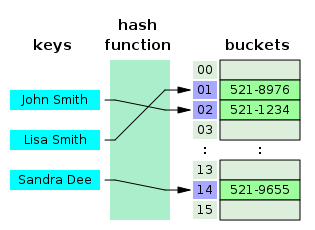 A data structure known as a hash table.
A data structure known as a hash table.
In computer science, a data structure is a data organization, management and storage format that enables efficient access and modification. More precisely, a data structure is a collection of data values, the relationships among them, and the functions or operations that can be applied to the data. Read more...- Neuropsychology is the study of the structure and function of the brain as they relate to specific psychological processes and behaviours. It is both an experimental and clinical field of psychology that aims to understand how behavior and cognition are influenced by brain functioning and is concerned with the diagnosis and treatment of behavioral and cognitive effects of neurological disorders. Whereas classical neurology focuses on the physiology of the nervous system and classical psychology is largely divorced from it, neuropsychology seeks to discover how the brain correlates with the mind. It thus shares concepts and concerns with neuropsychiatry and with behavioral neurology in general. The term neuropsychology has been applied to lesion studies in humans and animals. It has also been applied in efforts to record electrical activity from individual cells (or groups of cells) in higher primates (including some studies of human patients). It makes use of neuroscience, and shares an information processing view of the mind with cognitive psychology and cognitive science.
In practice, neuropsychologists tend to work in research settings (universities, laboratories or research institutions), clinical settings (medical hospitals or rehabilitation settings, often involved in assessing or treating patients with neuropsychological problems), or forensic settings or industry (often as clinical-trial consultants where CNS function is a concern). Read more... - Medical cybernetics is a branch of cybernetics which has been heavily affected by the development of the computer, which applies the concepts of cybernetics to medical research and practice. It covers an emerging working program for the application of systems- and communication theory, connectionism and decision theory on biomedical research and health related questions. Read more...
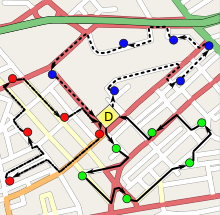 Efficient solutions to the vehicle routing problem require tools from combinatorial optimization and integer programming.
Efficient solutions to the vehicle routing problem require tools from combinatorial optimization and integer programming.
Applied mathematics is the application of mathematical methods by different fields such as science, engineering, business, computer science, and industry. Thus, applied mathematics is a combination of mathematical science and specialized knowledge. The term "applied mathematics" also describes the professional specialty in which mathematicians work on practical problems by formulating and studying mathematical models. In the past, practical applications have motivated the development of mathematical theories, which then became the subject of study in pure mathematics where abstract concepts are studied for their own sake. The activity of applied mathematics is thus intimately connected with research in pure mathematics. Read more...
Parallel computing is a type of computation in which many calculations or the execution of processes are carried out simultaneously. Large problems can often be divided into smaller ones, which can then be solved at the same time. There are several different forms of parallel computing: bit-level, instruction-level, data, and task parallelism. Parallelism has long been employed in high-performance computing, but it's gaining broader interest due to the physical constraints preventing frequency scaling. As power consumption (and consequently heat generation) by computers has become a concern in recent years, parallel computing has become the dominant paradigm in computer architecture, mainly in the form of multi-core processors.
Parallel computing is closely related to concurrent computing—they are frequently used together, and often conflated, though the two are distinct: it is possible to have parallelism without concurrency (such as bit-level parallelism), and concurrency without parallelism (such as multitasking by time-sharing on a single-core CPU). In parallel computing, a computational task is typically broken down into several, often many, very similar sub-tasks that can be processed independently and whose results are combined afterwards, upon completion. In contrast, in concurrent computing, the various processes often do not address related tasks; when they do, as is typical in distributed computing, the separate tasks may have a varied nature and often require some inter-process communication during execution. Read more...
The history of calculus is fraught with philosophical debates about the meaning and logical validity of fluxions or infinitesimal numbers. The standard way to resolve these debates is to define the operations of calculus using epsilon–delta procedures rather than infinitesimals. Non-standard analysis instead reformulates the calculus using a logically rigorous notion of infinitesimal numbers.
Non-standard analysis was originated in the early 1960s by the mathematician Abraham Robinson. He wrote: Read more...- In mathematics, a Lie algebra (pronounced /liː/ "Lee") is a vector space
together with a non-associative, alternating bilinear map
, called the Lie bracket, satisfying the Jacobi identity.
Lie algebras are closely related to Lie groups, which are groups that are also smooth manifolds, with the property that the group operations of multiplication and inversion are smooth maps. Any Lie group gives rise to a Lie algebra. Conversely, to any finite-dimensional Lie algebra over real or complex numbers, there is a corresponding connected Lie group unique up to covering (Lie's third theorem). This correspondence between Lie groups and Lie algebras allows one to study Lie groups in terms of Lie algebras. Read more... - Linguistics is the scientific study of language. It involves an analysis of language form, language meaning, and language in context.
Linguistic study was originally motivated by the correct description of classical liturgical language, notably that of Sanskrit grammar, or by the development of logic and rhetoric in ancient Greece, leading to a grammatical tradition in Hellenism.
Beginning around the 4th century BCE, China also developed its own grammatical traditions. Traditions of Arabic grammar and Hebrew grammar developed during the Middle Ages, also in a religious context. Read more...  Flowchart of an algorithm (Euclid's algorithm) for calculating the greatest common divisor (g.c.d.) of two numbers a and b in locations named A and B. The algorithm proceeds by successive subtractions in two loops: IF the test B ≥ A yields "yes" (or true) (more accurately the number b in location B is greater than or equal to the number a in location A) THEN, the algorithm specifies B ← B − A (meaning the number b − a replaces the old b). Similarly, IF A > B, THEN A ← A − B. The process terminates when (the contents of) B is 0, yielding the g.c.d. in A. (Algorithm derived from Scott 2009:13; symbols and drawing style from Tausworthe 1977).
Flowchart of an algorithm (Euclid's algorithm) for calculating the greatest common divisor (g.c.d.) of two numbers a and b in locations named A and B. The algorithm proceeds by successive subtractions in two loops: IF the test B ≥ A yields "yes" (or true) (more accurately the number b in location B is greater than or equal to the number a in location A) THEN, the algorithm specifies B ← B − A (meaning the number b − a replaces the old b). Similarly, IF A > B, THEN A ← A − B. The process terminates when (the contents of) B is 0, yielding the g.c.d. in A. (Algorithm derived from Scott 2009:13; symbols and drawing style from Tausworthe 1977).
In mathematics and computer science, an algorithm (/ˈælɡərɪðəm/ ( listen)) is an unambiguous specification of how to solve a class of problems. Algorithms can perform calculation, data processing, and automated reasoning tasks.
listen)) is an unambiguous specification of how to solve a class of problems. Algorithms can perform calculation, data processing, and automated reasoning tasks.
As an effective method, an algorithm can be expressed within a finite amount of space and time and in a well-defined formal language for calculating a function. Starting from an initial state and initial input (perhaps empty), the instructions describe a computation that, when executed, proceeds through a finite number of well-defined successive states, eventually producing "output" and terminating at a final ending state. The transition from one state to the next is not necessarily deterministic; some algorithms, known as randomized algorithms, incorporate random input. Read more...- Some scholars trace the origins of natural science as far back as pre-literate human societies, where understanding the natural world was necessary for survival. People observed and built up knowledge about the behavior of animals and the usefulness of plants as food and medicine, which was passed down from generation to generation. These primitive understandings gave way to more formalized inquiry around 3500 to 3000 BC in the Mesopotamian and Ancient Egyptian cultures, which produced the first known written evidence of natural philosophy, the precursor of natural science. While the writings show an interest in astronomy, mathematics and other aspects of the physical world, the ultimate aim of inquiry about nature's workings was in all cases religious or mythological, not scientific.
A tradition of scientific inquiry also emerged in Ancient China, where Taoist alchemists and philosophers experimented with elixirs to extend life and cure ailments. They focused on the yin and yang, or contrasting elements in nature; the yin was associated with femininity and coldness, while yang was associated with masculinity and warmth. The five phases – fire, earth, metal, wood and water – described a cycle of transformations in nature. Water turned into wood, which turned into fire when it burned. The ashes left by fire were earth. Using these principles, Chinese philosophers and doctors explored human anatomy, characterizing organs as predominantly yin or yang and understood the relationship between the pulse, the heart and the flow of blood in the body centuries before it became accepted in the West. Read more... - A lattice is an abstract structure studied in the mathematical subdisciplines of order theory and abstract algebra. It consists of a partially ordered set in which every two elements have a unique supremum (also called a least upper bound or join) and a unique infimum (also called a greatest lower bound or meet). An example is given by the natural numbers, partially ordered by divisibility, for which the unique supremum is the least common multiple and the unique infimum is the greatest common divisor.
Lattices can also be characterized as algebraic structures satisfying certain axiomatic identities. Since the two definitions are equivalent, lattice theory draws on both order theory and universal algebra. Semilattices include lattices, which in turn include Heyting and Boolean algebras. These "lattice-like" structures all admit order-theoretic as well as algebraic descriptions. Read more... - In computer science, functional programming is a programming paradigm—a style of building the structure and elements of computer programs—that treats computation as the evaluation of mathematical functions and avoids changing-state and mutable data. It is a declarative programming paradigm, which means programming is done with expressions or declarations instead of statements. Functional code is idempotent, the output value of a function depends only on the arguments that are passed to the function, so calling a function f twice with the same value for an argument x produces the same result f(x) each time; this is in contrast to procedures depending on a local or global state, which may produce different results at different times when called with the same arguments but a different program state. Eliminating side effects, i.e., changes in state that do not depend on the function inputs, can make it much easier to understand and predict the behavior of a program, which is one of the key motivations for the development of functional programming.
Functional programming has its origins in lambda calculus, a formal system developed in the 1930s to investigate computability, the Entscheidungsproblem, function definition, function application, and recursion. Many functional programming languages can be viewed as elaborations on the lambda calculus. Another well-known declarative programming paradigm, logic programming, is based on relations. Read more... - Governmental impact on science during World War II represents the effect of public administration on technological development that provided many advantages to the armed forces, economies and societies in their strategies during the war. Read more...
- The Scientific Revolution was a series of events that marked the emergence of modern science during the early modern period, when developments in mathematics, physics, astronomy, biology (including human anatomy) and chemistry transformed the views of society about nature. The Scientific Revolution took place in Europe towards the end of the Renaissance period and continued through the late 18th century, influencing the intellectual social movement known as the Enlightenment. While its dates are debated, the publication in 1543 of Nicolaus Copernicus's De revolutionibus orbium coelestium (On the Revolutions of the Heavenly Spheres) is often cited as marking the beginning of the Scientific Revolution.
The concept of a scientific revolution taking place over an extended period emerged in the eighteenth century in the work of Jean Sylvain Bailly, who saw a two-stage process of sweeping away the old and establishing the new. The beginning of the Scientific Revolution, the Scientific Renaissance, was focused on the recovery of the knowledge of the ancients; this is generally considered to have ended in 1632 with publication of Galileo's Dialogue Concerning the Two Chief World Systems. The completion of the Scientific Revolution is attributed to the "grand synthesis" of Isaac Newton's 1687 Principia. The work formulated the laws of motion and universal gravitation thereby completing the synthesis of a new cosmology. By the end of the 18th century, the Age of Enlightenment that followed Scientific Revolution had given way to the "Age of Reflection." Read more...  The IBM Blue Gene/P supercomputer "Intrepid" at Argonne National Laboratory runs 164,000 processor cores using normal data center air conditioning, grouped in 40 racks/cabinets connected by a high-speed 3-D torus network.
The IBM Blue Gene/P supercomputer "Intrepid" at Argonne National Laboratory runs 164,000 processor cores using normal data center air conditioning, grouped in 40 racks/cabinets connected by a high-speed 3-D torus network.
A supercomputer is a computer with a high level of performance compared to a general-purpose computer. The performance of a supercomputer is commonly measured in floating-point operations per second (FLOPS) instead of million instructions per second (MIPS). Since 2017, there are supercomputers which can perform up to nearly a hundred quadrillion FLOPS. Since November 2017, all of the world's fastest 500 supercomputers run Linux-based operating systems. Additional research is being conducted in China, the United States, the European Union, Taiwan and Japan to build even faster, more powerful and more technologically superior exascale supercomputers.
Supercomputers play an important role in the field of computational science, and are used for a wide range of computationally intensive tasks in various fields, including quantum mechanics, weather forecasting, climate research, oil and gas exploration, molecular modeling (computing the structures and properties of chemical compounds, biological macromolecules, polymers, and crystals), and physical simulations (such as simulations of the early moments of the universe, airplane and spacecraft aerodynamics, the detonation of nuclear weapons, and nuclear fusion). Throughout their history, they have been essential in the field of cryptanalysis. Read more...- This timeline of the history of scientific method shows an overview of the cultural inventions that have contributed to the development of the scientific method. For a detailed account, see History of the scientific method. Read more...
- Linear time-invariant theory, commonly known as LTI system theory, comes from applied mathematics and has direct applications in NMR spectroscopy, seismology, circuits, signal processing, control theory, and other technical areas. It investigates the response of a linear and time-invariant system to an arbitrary input signal. Trajectories of these systems are commonly measured and tracked as they move through time (e.g., an acoustic waveform), but in applications like image processing and field theory, the LTI systems also have trajectories in spatial dimensions. Thus, these systems are also called linear translation-invariant to give the theory the most general reach. In the case of generic discrete-time (i.e., sampled) systems, linear shift-invariant is the corresponding term. A good example of LTI systems are electrical circuits that can be made up of resistors, capacitors, and inductors. Read more...
- Information retrieval (IR) is the activity of obtaining information system resources relevant to an information need from a collection of information resources. Searches can be based on full-text or other content-based indexing. Information retrieval is the science of searching for information in a document, searching for documents themselves, and also searching for metadata that describe data, and for databases of texts, images or sounds.
Automated information retrieval systems are used to reduce what has been called information overload. An IR system is a software that provide access to books, journals and other documents, stores them and manages the document. Web search engines are the most visible IR applications. Read more...
A control system manages, commands, directs, or regulates the behavior of other devices or systems using control loops. It can range from a single home heating controller using a thermostat controlling a domestic boiler to large Industrial control systems which are used for controlling processes or machines.
For continuously modulated control, a feedback controller is used to automatically control a process or operation. The control system compares the value or status of the process variable (PV) being controlled with the desired value or setpoint (SP), and applies the difference as a control signal to bring the process variable output of the plant to the same value as the setpoint. Read more...- Probability is a measure of the likeliness that an event will occur. Probability is used to quantify an attitude of mind towards some proposition of whose truth we are not certain. The proposition of interest is usually of the form "A specific event will occur." The attitude of mind is of the form "How certain are we that the event will occur?" The certainty we adopt can be described in terms of a numerical measure and this number, between 0 and 1 (where 0 indicates impossibility and 1 indicates certainty), we call probability. Probability theory is used extensively in statistics, mathematics, science and philosophy to draw conclusions about the likelihood of potential events and the underlying mechanics of complex systems. Read more...
- In combinatorial mathematics, a block design is a set together with a family of subsets (repeated subsets are allowed at times) whose members are chosen to satisfy some set of properties that are deemed useful for a particular application. These applications come from many areas, including experimental design, finite geometry, software testing, cryptography, and algebraic geometry. Many variations have been examined, but the most intensely studied are the balanced incomplete block designs (BIBDs or 2-designs) which historically were related to statistical issues in the design of experiments.
A block design in which all the blocks have the same size is called uniform. The designs discussed in this article are all uniform. Pairwise balanced designs (PBDs) are examples of block designs that are not necessarily uniform. Read more...  An example of mathematical physics: solutions of Schrödinger's equation for quantum harmonic oscillators (left) with their amplitudes (right).
An example of mathematical physics: solutions of Schrödinger's equation for quantum harmonic oscillators (left) with their amplitudes (right).
Mathematical physics refers to the development of mathematical methods for application to problems in physics. The Journal of Mathematical Physics defines the field as "the application of mathematics to problems in physics and the development of mathematical methods suitable for such applications and for the formulation of physical theories". It is a branch of applied mathematics, but deals with physical problems. Read more...- A compiler is a computer program that transforms computer code written in one programming language (the source language) into another programming language (the target language). Compilers are a type of translator that support digital devices, primarily computers. The name compiler is primarily used for programs that translate source code from a high-level programming language to a lower level language (e.g., assembly language, object code, or machine code) to create an executable program.
However, there are many different types of compilers. If the compiled program can run on a computer whose CPU or operating system is different from the one on which the compiler runs, the compiler is a cross-compiler. A bootstrap compiler is written in the language that it intends to compile. A program that translates from a low-level language to a higher level one is a decompiler. A program that translates between high-level languages is usually called a source-to-source compiler or transpiler. A language rewriter is usually a program that translates the form of expressions without a change of language. The term compiler-compiler refers to tools used to create parsers that perform syntax analysis. Read more...  The Galaxy Nexus, capable of web browsing, e-mail access, video playback, document editing, file transfer, image editing, among many other tasks common on smartphones. A smartphone is a tool of mobile computing.
The Galaxy Nexus, capable of web browsing, e-mail access, video playback, document editing, file transfer, image editing, among many other tasks common on smartphones. A smartphone is a tool of mobile computing.
Mobile computing is human–computer interaction by which a computer is expected to be transported during normal usage, which allows for transmission of data, voice and video. Mobile computing involves mobile communication, mobile hardware, and mobile software. Communication issues include ad hoc networks and infrastructure networks as well as communication properties, protocols, data formats and concrete technologies. Hardware includes mobile devices or device components. Mobile software deals with the characteristics and requirements of mobile applications. Read more...- Demography (from prefix demo- from Ancient Greek δῆμος dēmos meaning "the people", and -graphy from γράφω graphō, implies "writing, description or measurement") is the statistical study of populations, especially human beings. As a very general science, it can analyze any kind of dynamic living population, i.e., one that changes over time or space (see population dynamics). Demography encompasses the study of the size, structure, and distribution of these populations, and spatial or temporal changes in them in response to birth, migration, aging, and death. Based on the demographic research of the earth, earth's population up to the year 2050 and 2100 can be estimated by demographers. Demographics are quantifiable characteristics of a given population.
Demographic analysis can cover whole societies or groups defined by criteria such as education, nationality, religion, and ethnicity. Educational institutions usually treat demography as a field of sociology, though there are a number of independent demography departments. Read more...  Color wheel graph of the function/ (z2 + 2 - 2i).
Color wheel graph of the function/ (z2 + 2 - 2i).
Hue represents the argument, brightness the magnitude.
Complex analysis, traditionally known as the theory of functions of a complex variable, is the branch of mathematical analysis that investigates functions of complex numbers. It is useful in many branches of mathematics, including algebraic geometry, number theory, analytic combinatorics, applied mathematics; as well as in physics, including the branches of hydrodynamics, thermodynamics, and particularly quantum mechanics. By extension, use of complex analysis also has applications in engineering fields such as nuclear, aerospace, mechanical and electrical engineering.
As a differentiable function of a complex variable is equal to the sum of its Taylor series (that is, it is analytic), complex analysis is particularly concerned with analytic functions of a complex variable (that is, holomorphic functions). Read more...- Political science is a social science which deals with systems of governance, and the analysis of political activities, political thoughts, and political behavior. It deals extensively with the theory and practice of politics which is commonly thought of as determining of the distribution of power and resources. Political scientists "see themselves engaged in revealing the relationships underlying political events and conditions, and from these revelations they attempt to construct general principles about the way the world of politics works."
Political science—occasionally called politicology—comprises numerous subfields, including comparative politics, political economy, international relations, political theory, public administration, public policy, and political methodology. Furthermore, political science is related to, and draws upon, the fields of economics, law, sociology, history, philosophy, geography, psychology/psychiatry, and anthropology. Read more... - Biocybernetics is the application of cybernetics to biological science, composed of biological disciplines that benefit from the application of cybernetics including neurology and multicellular systems. Biocybernetics plays a major role in systems biology, seeking to integrate different levels of information to understand how biological systems function.
Biocybernetics is an abstract science and is a fundamental part of theoretical biology, based upon the principles of systemics. Read more...
Did you know...
- ... that Chinese scientist Liu Xinyuan is a member of the National Academy of Sciences of Ukraine?
- ... that Windmill Hill Cavern, which provided the first scientifically accepted proof that humans and now-extinct animal species coexisted in Britain, was found accidentally while searching for a lost pickaxe?
- ... that though Landsat 4 suffered a second failure in 1993 that stopped it from transmitting most scientific data, it continued broadcasting telemetry, tracking, and command data until 2001?
- ... that the Pugwashite, Patricia Lindop, worked with Nobel Prize winner Joseph Rotblat on the effects of radiation on living organisms?
- ... that according to primatologists Robert Seyfarth and Dorothy Cheney, successful baboons use rules like those in Jane Austen novels: "be nice to your relatives and get in with the high-ranking relatives"?
- ... that Benty Grange is designated a Site of Special Scientific Interest, but not because of the boar-crested helmet discovered there?
- ... that neuroscientist Yang Dan and her team discovered that mice either enter a dream state or eat more in response to activation of certain brain neurons?
- ... that the name of the undersea volcano Ita Mai Tai (No Damn Good) was given by a scientist presumably upset by unsuccessful attempts to drill into it?
- ... that in 1981, Elnora M. Gilfoyle became the first occupational therapist to receive an honorary Doctor of Science degree?
- ... that Haifan Lin's discovery of piRNAs was named by Science as one of the top breakthroughs of 2006?
- ... that in 1939, Benjamin Seielstad drew four different versions of the end of the world for Popular Science Monthly?
- ... that Charlie Lee created Litecoin in his spare time while working at Google?
- ... that Russian scientist Natan Yavlinsky was credited as the inventor and developer of the world's first working tokamak?
- ... that the Hellenized Syrian satirist Lucian wrote the novel A True Story, sometimes regarded as the first work of science fiction, in the second century AD?
- ... that neuroendocrinologist Catherine Woolley found evidence of brain plasticity using a technique described in 1873?
- ... that Gavin Lowe went from being at John's to being at Hugh's, but finally ended up at Catherine's?
- ... that pharmacologist Li Lianda won a national science award for his research on the traditional Chinese medical concept of blood stasis?
- ... that William Gould Young was the first faculty member at UCLA to be inducted into the National Academy of Sciences, and the university's chemistry building was renamed in his honor?
- ... that Li Lin, her husband, and her father were all academicians of the Chinese Academy of Sciences?
- ... that one of the scientific names in use for the Kimberley death adder was given in honour of actor Burt Lancaster?
Need help?
Do you have a question about Science that you can't find the answer to?
Consider asking it at the Wikipedia reference desk.
Get involved
For editor resources and to collaborate with other editors on improving Wikipedia's Science-related articles, see WikiProject Science.
Selected images
The Universe represented as multiple disk-shaped slices across time, which passes from left to right.
In economics, the supply and demand model describes how prices vary as a result of a balance between product availability and demand.
Combustion and chemical reactions were studied by Michael Faraday and reported in his lectures before the Royal Institution: The Chemical History of a Candle, 1861.
German-born scientist Albert Einstein (1879–1955) developed the theory of relativity. He also won the Nobel Prize in Physics in 1921 for his work in theoretical physics.
Charles Darwin in 1854, by then working towards publication of On the Origin of Species.
Isaac Newton, shown here in a 1689 portrait, made seminal contributions to classical mechanics, gravity, and optics. Newton shares credit with Gottfried Leibniz for the development of calculus.
A humanoid robotic hand (see Shadow Hand system).
English philosopher and physician John Locke (1632–1704), a leading philosopher of British empiricism
De potentiis anime sensitive, Gregor Reisch (1504) Margarita philosophica. Medieval science postulated a ventricle of the brain as the location for our common sense, where the forms from our sensory systems commingled.
Dinosaur exhibit in the Houston Museum of Natural Science
The central star IRAS 10082-5647 was captured by the Advanced Camera for Surveys aboard the Hubble Space Telescope.
Cover of the first volume of the scientific journal Science in 1880.
Clay models of animal livers dating between the nineteenth and eighteenth centuries BCE, found in the royal palace in Mari, Syria
Results of seven papers from 2004–2015 assessing the overwhelming scientific consensus on man-made global warming (see Surveys of scientists' views on climate change), in contrast to the political controversy over this issue, particularly in the United States.
Physicists in front of the Royal Society building in London (1952).
Marie Curie was the first person to be awarded two Nobel Prizes: Physics in 1903 and Chemistry in 1911.
Galileo Galilei, regarded as the father of modern science.
Aristotle, 384–322 BCE, one of the early figures in the development of the scientific method.
A simulated event in the CMS detector of the Large Hadron Collider, featuring a possible appearance of the Higgs boson.
Astronomy became more accurate after Tycho Brahe devised his scientific instruments for measuring angles between two celestial bodies, before the invention of the telescope. Brahe's observations were the basis for Kepler's laws.
The Commonwealth Scientific and Industrial Research Organisation (CSIRO) Main Entomology Building in Australia
The Austrian-British philosopher of science Karl Popper (1902–1994) in 1990. He is best known for his work on empirical falsification.
In the news
- 7 February 2019 –
- NASA scientists report the MarCO satellites, two CubeSats in deep space, have lost contact with Planet Earth. (CNN)
- 30 January 2019 – Cancer research
- An Israeli team of scientists claim to have developed a cure for cancer. This claim is criticized by other scientists, who say it is likely faked. (Times of Israel)
- 23 January 2019 – 2019 in spaceflight
- Blue Origin successfully launches its New Shepard 3 rocket and completes the tenth sub-orbital test flight, reaching an altitude of 106.9 km (351,000 ft), carrying its crew capsule and making a controlled upright landing in West Texas.[1].[2]
Selected branches of social science
- Aesthetics (/ɛsˈθɛtɪks,
iːs-, ) is a branch of philosophy that deals with the nature of art, beauty and taste and with the creation or appreciation of beauty.æs-/
In its more technical epistemological perspective, it is defined as the study of subjective and sensori-emotional values, or sometimes called judgments of sentiment and taste. Aesthetics studies how artists imagine, create and perform works of art; how people use, enjoy, and criticize art; and what happens in their minds when they look at paintings, listen to music, or read poetry, and understand what they see and hear. It also studies how they feel about art—why they like some works and not others, and how art can affect their moods, beliefs, and attitude toward life. The phrase was coined in English in the 18th century. Read more...
Feminist economics is the critical study of economics and economies, with a focus on gender-aware and inclusive economic inquiry and policy analysis. Feminist economic researchers include academics, activists, policy theorists, and practitioners. Much feminist economic research focuses on topics that have been neglected in the field, such as care work, intimate partner violence, or on economic theories which could be improved through better incorporation of gendered effects and interactions, such as between paid and unpaid sectors of economies. Other feminist scholars have engaged in new forms of data collection and measurement such as the Gender Empowerment Measure (GEM), and more gender-aware theories such as the capabilities approach. Feminist economics is oriented towards the goal of "enhancing the well-being of children, women, and men in local, national, and transnational communities."
Feminist economists call attention to the social constructions of traditional economics, questioning the extent to which it is positive and objective, and showing how its models and methods are biased by an exclusive attention to masculine-associated topics and a one-sided favoring of masculine-associated assumptions and methods. While economics traditionally focused on markets and masculine-associated ideas of autonomy, abstraction and logic, feminist economists call for a fuller exploration of economic life, including such "culturally feminine" topics such as family economics, and examining the importance of connections, concreteness, and emotion in explaining economic phenomena. Read more...
Legal management (also offered as: legal studies, or paralegal studies) is an academic and professional discipline that is a hybrid between the study of law and management (i.e. business administration, public administration, etc.). It is generally considered as the best preparatory law program for those who aspire to become members of a bar. Often, alumni of legal management programmes pursue a professional degree in law such as Juris Doctor (JD) or Bachelor of Laws (Ll.B.) while some profess as paralegals, law clerks, political analysts, politicians, public administrators, entrepreneurs, business executives, or pursue careers in the academe.
The degree was designed in the Philippines and was first introduced in Ateneo de Manila University in the 1980s by former Philippine Supreme Court Chief Justice Renato Corona. It is also offered in the United States, most notably, at the University of California Berkeley. Read more...- The philosophy of education examines the goals, forms, methods, and meaning of education. The term is used to describe both fundamental philosophical analysis of these themes and the description or analysis of particular pedagogical approaches. Considerations of how the profession relates to broader philosophical or sociocultural contexts may be included. The philosophy of education thus overlaps with the field of education and applied philosophy.
For example, philosophers of education study what constitutes upbringing and education, the values and norms revealed through upbringing and educational practices, the limits and legitimization of education as an academic discipline, and the relation between educational theory and practice. Read more... - Game theory is the study of mathematical models of strategic interaction between rational decision-makers. It has applications in all fields of social science, as well as in logic and computer science. Originally, it addressed zero-sum games, in which one person's gains result in losses for the other participants. Today, game theory applies to a wide range of behavioral relations, and is now an umbrella term for the science of logical decision making in humans, animals, and computers.
Modern game theory began with the idea regarding the existence of mixed-strategy equilibria in two-person zero-sum games and its proof by John von Neumann. Von Neumann's original proof used the Brouwer fixed-point theorem on continuous mappings into compact convex sets, which became a standard method in game theory and mathematical economics. His paper was followed by the 1944 book Theory of Games and Economic Behavior, co-written with Oskar Morgenstern, which considered cooperative games of several players. The second edition of this book provided an axiomatic theory of expected utility, which allowed mathematical statisticians and economists to treat decision-making under uncertainty. Read more...  Frontispiece to Alfred Russel Wallace's book The Geographical Distribution of Animals
Frontispiece to Alfred Russel Wallace's book The Geographical Distribution of Animals
Biogeography is the study of the distribution of species and ecosystems in geographic space and through geological time. Organisms and biological communities often vary in a regular fashion along geographic gradients of latitude, elevation, isolation and habitat area. Phytogeography is the branch of biogeography that studies the distribution of plants. Zoogeography is the branch that studies distribution of animals.
Knowledge of spatial variation in the numbers and types of organisms is as vital to us today as it was to our early human ancestors, as we adapt to heterogeneous but geographically predictable environments. Biogeography is an integrative field of inquiry that unites concepts and information from ecology, evolutionary biology, geology, and physical geography. Read more...- Children's geographies is an area of study within human geography and Childhood studies which involves researching the places and spaces of children's lives. Read more...
Oceanography (compound of the Greek words ὠκεανός meaning "ocean" and γράφω meaning "write"), also known as oceanology, is the study of the physical and biological aspects of the ocean. It is an Earth science, which covers a wide range of topics, including ecosystem dynamics; ocean currents, waves, and geophysical fluid dynamics; plate tectonics and the geology of the sea floor; and fluxes of various chemical substances and physical properties within the ocean and across its boundaries. These diverse topics reflect multiple disciplines that oceanographers blend to further knowledge of the world ocean and understanding of processes within: astronomy, biology, chemistry, climatology, geography, geology, hydrology, meteorology and physics. Paleoceanography studies the history of the oceans in the geologic past. Read more...- Ethnopoetics is a method of recording text versions of oral poetry or narrative performances (i.e. verbal lore) that uses poetic lines, verses, and stanzas (instead of prose paragraphs) to capture the formal, poetic performance elements which would otherwise be lost in the written texts. The goal of any ethnopoetic text is to show how the techniques of unique oral performers enhance the aesthetic value of their performances within their specific cultural contexts. Major contributors to ethnopoetic theory include Jerome Rothenberg, Dennis Tedlock, and Dell Hymes. Ethnopoetics is considered a subfield of ethnology, anthropology, folkloristics, stylistics, linguistics, and literature and translation studies. Read more...
- Industrial and organizational psychology (I/O psychology), which is also known as occupational psychology, organizational psychology, and work and organizational psychology, is an applied discipline within psychology. I/O psychology is the science of human behaviour relating to work and applies psychological theories and principles to organizations and individuals in their places of work as well as the individual's work-life more generally. I/O psychologists are trained in the scientist–practitioner model. They contribute to an organization's success by improving the performance, motivation, job satisfaction, and occupational safety and health as well as the overall health and well-being of its employees. An I/O psychologist conducts research on employee behaviours and attitudes, and how these can be improved through hiring practices, training programs, feedback, and management systems.
As of 2018, I/O psychology is one of the 16 recognized specialties by the American Psychological Association (APA) in the United States. It is represented by Division 14 of the APA, and was formally known as the Society for Industrial and Organizational Psychology (SIOP). In the United Kingdom, industrial and organizational psychologists are referred to as occupational psychologists. Occupational psychology in the UK is one of nine 'protected titles' within the profession "practitioner psychologist" regulated by the Health and Care Professions Council. In the UK, graduate programs in psychology, including occupational psychology, are accredited by the British Psychological Society. Read more...
A time series is a series of data points indexed (or listed or graphed) in time order. Most commonly, a time series is a sequence taken at successive equally spaced points in time. Thus it is a sequence of discrete-time data. Examples of time series are heights of ocean tides, counts of sunspots, and the daily closing value of the Dow Jones Industrial Average.
Time series are very frequently plotted via line charts. Time series are used in statistics, signal processing, pattern recognition, econometrics, mathematical finance, weather forecasting, earthquake prediction, electroencephalography, control engineering, astronomy, communications engineering, and largely in any domain of applied science and engineering which involves temporal measurements. Read more...- Philosophy of science is a sub-field of philosophy concerned with the foundations, methods, and implications of science. The central questions of this study concern what qualifies as science, the reliability of scientific theories, and the ultimate purpose of science. This discipline overlaps with metaphysics, ontology, and epistemology, for example, when it explores the relationship between science and truth.
There is no consensus among philosophers about many of the central problems concerned with the philosophy of science, including whether science can reveal the truth about unobservable things and whether scientific reasoning can be justified at all. In addition to these general questions about science as a whole, philosophers of science consider problems that apply to particular sciences (such as biology or physics). Some philosophers of science also use contemporary results in science to reach conclusions about philosophy itself. Read more... - The following outline is provided as an overview of and topical guide to library science:
Library science – study of issues related to libraries and the information fields. This includes academic studies regarding how library resources are used and how people interact with library systems. The organization of knowledge for efficient retrieval of relevant information is also a major research goal of library science. Being interdisciplinary, it overlaps with computer science, various social sciences, statistics, and systems analysis. It is also called "library and information science", abbreviated "LIS". Read more...
Zooarchaeology (or archaeozoology) is the branch of archaeology that studies faunal remains related to ancient people. Faunal remains are the items left behind when an animal dies. It includes: bones, shells, hair, chitin, scales, hides, proteins and DNA. Of these items, bones and shells are the ones that occur most frequently at archaeological sites where faunal remains can be found. Most of the time, most of the faunal remains do not survive. They often decompose or break because of various circumstances. This can cause difficulties in identifying the remains and interpreting their significance. Read more... Partizánske in Slovakia – an example of a typical planned European industrial city founded in 1938 together with a shoemaking factory in which practically all adult inhabitants of the city were employed.
Partizánske in Slovakia – an example of a typical planned European industrial city founded in 1938 together with a shoemaking factory in which practically all adult inhabitants of the city were employed.
Urban planning is a technical and political process concerned with the development and design of land use and the built environment, including air, water, and the infrastructure passing into and out of urban areas, such as transportation, communications, and distribution networks. Urban planning deals with physical layout of human settlements. The primary concern is the public welfare, which includes considerations of efficiency, sanitation, protection and use of the environment, as well as effects on social and economic activities. Urban planning is considered an interdisciplinary field that includes social, engineering and design sciences. It is closely related to the field of urban design and some urban planners provide designs for streets, parks, buildings and other urban areas. Urban planning is also referred to as urban and regional planning, regional planning, town planning, city planning, rural planning, urban development or some combination in various areas worldwide.
Urban planning guides orderly development in urban, suburban and rural areas. Although predominantly concerned with the planning of settlements and communities, urban planning is also responsible for the planning and development of water use and resources, rural and agricultural land, parks and conserving areas of natural environmental significance. Practitioners of urban planning are concerned with research and analysis, strategic thinking, architecture, urban design, public consultation, policy recommendations, implementation and management. Enforcement methodologies include governmental zoning, planning permissions, and building codes, as well as private easements and restrictive covenants. Read more...- Public policy is the principled guide to action taken by the administrative executive branches of the state with regard to a class of issues, in a manner consistent with law and institutional customs. Read more...
- Gerontology is the study of the social, cultural, psychological, cognitive, and biological aspects of ageing. The word was coined by Ilya Ilyich Mechnikov in 1903, from the Greek γέρων, geron, "old man" and -λογία, -logia, "study of". The field is distinguished from geriatrics, which is the branch of medicine that specializes in the treatment of existing disease in older adults. Gerontologists include researchers and practitioners in the fields of biology, nursing, medicine, criminology, dentistry, social work, physical and occupational therapy, psychology, psychiatry, sociology, economics, political science, architecture, geography, pharmacy, public health, housing, and anthropology.
The multidisciplinary nature of gerontology means that there are a number of sub-fields which overlap with gerontology. There are policy issues, for example, involved in government planning and the operation of nursing homes, investigating the effects of an ageing population on society, and the design of residential spaces for older people that facilitate the development of a sense of place or home. Dr. Lawton, a behavioral psychologist at the Philadelphia Geriatric Center, was among the first to recognize the need for living spaces designed to accommodate the elderly, especially those with Alzheimer's disease. As an academic discipline the field is relatively new. The USC Leonard Davis School created the first PhD, master's and bachelor's degree programs in gerontology in 1975. Read more...
Criminology (from Latin crīmen, "accusation" originally derived from the Ancient Greek verb "krino" "κρίνω", and Ancient Greek -λογία, -logy|-logia, from "logos" meaning: “word,” “reason,” or “plan”) is the scientific study of the nature, extent, management, causes, control, consequences, and prevention of criminal behavior, both on individual and social levels. Criminology is an interdisciplinary field in both the behavioral and social sciences, drawing primarily upon the research of sociologists, psychologists, philosophers, psychiatrists, biologists, social anthropologists, as well as scholars of law.
The term criminology was coined in 1885 by Italian law professor Raffaele Garofalo as criminologia. Later, French anthropologist Paul Topinard used the analogous French term criminologie. Read more...- Cognitive linguistics (CL) is an interdisciplinary branch of linguistics, combining knowledge and research from both psychology and linguistics. It describes how language interacts with cognition, how language forms our thoughts, and the evolution of language parallel with the change in the common mindset across time.
According to Merriam-Webster, the word "cognitive" is defined as "of, relating to, being, or involving conscious intellectual activity (such as thinking, reasoning, or remembering)". Merriam-Webster also defines linguistics as "the study of human speech including the units, nature, structure, and modification of language". Combining those two definitions together to form cognitive linguistics would provide the notion of the concepts and ideas discussed in the realm of CL. Within CL, the analysis of the conceptual and experiential basis of linguistic categories is of primary importance. The formal structures of language are studied not as if they were autonomous, but as reflections of general conceptual organization, categorization principles, processing mechanisms, and experiential and environmental influences. Read more... - Health psychology is the study of psychological and behavioral processes in health, illness, and healthcare. It is concerned with understanding how psychological, behavioral, and cultural factors contribute to physical health and illness. Psychological factors can affect health directly. For example, chronically occurring environmental stressors affecting the hypothalamic–pituitary–adrenal axis, cumulatively, can harm health. Behavioral factors can also affect a person's health. For example, certain behaviors can, over time, harm (smoking or consuming excessive amounts of alcohol) or enhance health (engaging in exercise). Health psychologists take a biopsychosocial approach. In other words, health psychologists understand health to be the product not only of biological processes (e.g., a virus, tumor, etc.) but also of psychological (e.g., thoughts and beliefs), behavioral (e.g., habits), and social processes (e.g., socioeconomic status and ethnicity).
By understanding psychological factors that influence health, and constructively applying that knowledge, health psychologists can improve health by working directly with individual patients or indirectly in large-scale public health programs. In addition, health psychologists can help train other healthcare professionals (e.g., physicians and nurses) to take advantage of the knowledge the discipline has generated, when treating patients. Health psychologists work in a variety of settings: alongside other medical professionals in hospitals and clinics, in public health departments working on large-scale behavior change and health promotion programs, and in universities and medical schools where they teach and conduct research. Read more...
Anthrozoology (also known as human–non-human-animal studies, or HAS) is the subset of ethnobiology that deals with interactions between humans and other animals. It is an interdisciplinary field that overlaps with other disciplines including anthropology, ethnology, medicine, psychology, veterinary medicine and zoology. A major focus of anthrozoologic research is the quantifying of the positive effects of human-animal relationships on either party and the study of their interactions. It includes scholars from fields such as anthropology, sociology, biology, history and philosophy.
Anthrozoology scholars, such as Pauleen Bennett recognize the lack of scholarly attention given to non-human animals in the past, and to the relationships between human and non-human animals, especially in the light of the magnitude of animal representations, symbols, stories and their actual physical presence in human societies. Rather than a unified approach, the field currently consists of several methods adapted from the several participating disciplines to encompass human-nonhuman animal relationships and occasional efforts to develop sui generis methods. Read more...- Neuroeconomics is an interdisciplinary field that seeks to explain human decision making, the ability to process multiple alternatives and to follow a course of action. It studies how economic behavior can shape our understanding of the brain, and how neuroscientific discoveries can constrain and guide models of economics.
It combines research from neuroscience, experimental and behavioral economics, and cognitive and social psychology. As research into decision-making behavior becomes increasingly computational, it has also incorporated new approaches from theoretical biology, computer science, and mathematics. Neuroeconomics studies decision making by using a combination of tools from these fields so as to avoid the shortcomings that arise from a single-perspective approach. In mainstream economics, expected utility (EU) and the concept of rational agents are still being used. Many economic behaviors are not fully explained by these models, such as heuristics and framing. Read more... - Economic geography has been defined by the geographers as the study of human's economic activities under varying sets of conditions which is associated with production, location, distribution, consumption, exchange of resources, and spatial organization of economic activities across the world. It represents a traditional subfield of the discipline of geography. However, many economists have also approached the field in ways more typical of the discipline of economics.
Economic geography has taken a variety of approaches to many different subject matters, including the location of industries, economies of agglomeration (also known as "linkages"), transportation, international trade, development, real estate, gentrification, ethnic economies, gendered economies, core-periphery theory, the economics of urban form, the relationship between the environment and the economy (tying into a long history of geographers studying culture-environment interaction), and globalization. Read more...
Sustainable development is the organizing principle for meeting human development goals while at the same time sustaining the ability of natural systems to provide the natural resources and ecosystem services upon which the economy and society depend. The desired result is a state of society where living conditions and resource use continue to meet human needs without undermining the integrity and stability of the natural system. Sustainable development can be classified as development that meets the needs of the present without compromising the ability of future generations.
While the modern concept of sustainable development is derived mostly from the 1987 Brundtland Report, it is also rooted in earlier ideas about sustainable forest management and twentieth century environmental concerns. As the concept developed, it has shifted to focus more on economic development, social development and environmental protection for future generations. It has been suggested that "the term 'sustainability' should be viewed as humanity's target goal of human-ecosystem equilibrium (homeostasis), while 'sustainable development' refers to the holistic approach and temporal processes that lead us to the end point of sustainability". Modern economies are endeavouring to reconcile ambitious economic development and obligations of preserving natural resources and ecosystems, as the two are usually seen as of conflicting nature. Instead of holding climate change commitments and other sustainability measures as a drug[vague] to economic development, turning and leveraging them into market opportunities will do greater good.[unbalanced opinion?] The economic development brought by such organized principles and practices in an economy is called Managed Sustainable Development (MSD).[attribution needed] Read more...- Military psychology is the research, design, and application of psychological theories and empirical data towards understanding, predicting, and countering behaviours in friendly and enemy forces, or in civilian populations. There is particular emphasis on behaviours that may be undesirable, threatening, or potentially dangerous to the conduct of military operations. Military psychology utilizes multiple different psychology sub-disciplines to encourage resiliency among military troops and counteract enemy forces for military victories. The stressors and mental illnesses studied under military psychology are not specific to the military. However, soldiers often face unique combinations of stressors within combat and war settings, and may go on to experience stress-related psychiatric disorders. Specific examples of the issues faced by military personnel include posttraumatic stress disorder (PTSD), guilt, family and partner difficulties, and nightmares and flashbacks. Applied military psychology is especially focused on counselling, and treatment of stress and fatigue of military personnel and their families. Read more...
- The following outline is provided as an overview of and topical guide to cartography:
Cartography (also called mapmaking) – study and practice of making and using maps or globes. Maps have traditionally been made using pen and paper, but the advent and spread of computers has revolutionized cartography. Read more... - In linguistics, morphology (/mɔːrˈfɒlədʒi/) is the study of words, how they are formed, and their relationship to other words in the same language. It analyzes the structure of words and parts of words, such as stems, root words, prefixes, and suffixes. Morphology also looks at parts of speech, intonation and stress, and the ways context can change a word's pronunciation and meaning. Morphology differs from morphological typology, which is the classification of languages based on their use of words, and lexicology, which is the study of words and how they make up a language's vocabulary.
While words, along with clitics, are generally accepted as being the smallest units of syntax, in most languages, if not all, many words can be related to other words by rules that collectively describe the grammar for that language. For example, English speakers recognize that the words dog and dogs are closely related, differentiated only by the plurality morpheme "-s", only found bound to noun phrases. Speakers of English, a fusional language, recognize these relations from their innate knowledge of English's rules of word formation. They infer intuitively that dog is to dogs as cat is to cats; and, in similar fashion, dog is to dog catcher as dish is to dishwasher. By contrast, Classical Chinese has very little morphology, using almost exclusively unbound morphemes ("free" morphemes) and depending on word order to convey meaning. (Most words in modern Standard Chinese ["Mandarin"], however, are compounds and most roots are bound.) These are understood as grammars that represent the morphology of the language. The rules understood by a speaker reflect specific patterns or regularities in the way words are formed from smaller units in the language they are using, and how those smaller units interact in speech. In this way, morphology is the branch of linguistics that studies patterns of word formation within and across languages and attempts to formulate rules that model the knowledge of the speakers of those languages. Read more...
The following outline is provided as an overview of and topical guide to geography:
Geography – study of earth and its people. Read more...
Development geography is a branch of geography which refers to the standard of living and its quality of life of its human inhabitants. In this context, development is a process of change that affects people's lives. It may involve an improvement in the quality of life as perceived by the people undergoing change. However, development is not always a positive process. Gunder Frank commented on the global economic forces that lead to the development of underdevelopment. This is covered in his dependency theory.
In development geography, geographers study spatial patterns in development. They try to find by what characteristics they can measure development by looking at economic, political and social factors. They seek to understand both the geographical causes and consequences of varying development. Studies compare More Economically Developed Countries (MEDCs) with Less Economically Developed Countries (LEDCs). Additionally variations within countries are looked at such as the differences between northern and southern Italy, the Mezzogiorno. Read more...- Socioeconomics (also known as social economics) is the social science that studies how economic activity affects and is shaped by social processes. In general it analyzes how societies progress, stagnate, or regress because of their local or regional economy, or the global economy. Societies are divided into 3 groups: social, cultural and economic. Read more...
- Systems psychology is a branch of both theoretical psychology and applied psychology that studies human behaviour and experience in complex systems. It is inspired by systems theory and systems thinking, and based on the theoretical work of Roger Barker, Gregory Bateson, Humberto Maturana and others. Groups and individuals are considered as systems in homeostasis. Alternative terms here are "systemic psychology", "systems behavior", and "systems-based psychology". Read more...
- Evolutionary economics is part of mainstream economics as well as a heterodox school of economic thought that is inspired by evolutionary biology. Much like mainstream economics, it stresses complex interdependencies, competition, growth, structural change, and resource constraints but differs in the approaches which are used to analyze these phenomena.
Evolutionary economics deals with the study of processes that transform economy for firms, institutions, industries, employment, production, trade and growth within, through the actions of diverse agents from experience and interactions, using evolutionary methodology. Evolutionary economics analyses the unleashing of a process of technological and institutional innovation by generating and testing a diversity of ideas which discover and accumulate more survival value for the costs incurred than competing alternatives. The evidence suggests that it could be adaptive efficiency that defines economic efficiency. Mainstream economic reasoning begins with the postulates of scarcity and rational agents (that is, agents modeled as maximizing their individual welfare), with the "rational choice" for any agent being a straightforward exercise in mathematical optimization. There has been renewed interest in treating economic systems as evolutionary systems in the developing field of Complexity economics. Read more... 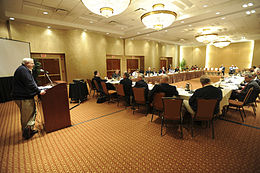 Public administration is both an academic discipline and a field of practice; the latter is depicted in this picture of United States federal public servants at a meeting.
Public administration is both an academic discipline and a field of practice; the latter is depicted in this picture of United States federal public servants at a meeting.
Public administration is the implementation of government policy and also an academic discipline that studies this implementation and prepares civil servants for working in the public service. As a "field of inquiry with a diverse scope" whose fundamental goal is to "advance management and policies so that government can function". Some of the various definitions which have been offered for the term are: "the management of public programs"; the "translation of politics into the reality that citizens see every day"; and "the study of government decision making, the analysis of the policies themselves, the various inputs that have produced them, and the inputs necessary to produce alternative policies."
Public administration is "centrally concerned with the organization of government policies and programs as well as the behavior of officials (usually non-elected) formally responsible for their conduct". Many unelected public servants can be considered to be public administrators, including heads of city, county, regional, state and federal departments such as municipal budget directors, human resources (HR) administrators, city managers, census managers, state mental health directors, and cabinet secretaries. Public administrators are public servants working in public departments and agencies, at all levels of government. Read more...- Health psychology is the study of psychological and behavioral processes in health, illness, and healthcare. It is concerned with understanding how psychological, behavioral, and cultural factors contribute to physical health and illness. Psychological factors can affect health directly. For example, chronically occurring environmental stressors affecting the hypothalamic–pituitary–adrenal axis, cumulatively, can harm health. Behavioral factors can also affect a person's health. For example, certain behaviors can, over time, harm (smoking or consuming excessive amounts of alcohol) or enhance health (engaging in exercise). Health psychologists take a biopsychosocial approach. In other words, health psychologists understand health to be the product not only of biological processes (e.g., a virus, tumor, etc.) but also of psychological (e.g., thoughts and beliefs), behavioral (e.g., habits), and social processes (e.g., socioeconomic status and ethnicity).
By understanding psychological factors that influence health, and constructively applying that knowledge, health psychologists can improve health by working directly with individual patients or indirectly in large-scale public health programs. In addition, health psychologists can help train other healthcare professionals (e.g., physicians and nurses) to take advantage of the knowledge the discipline has generated, when treating patients. Health psychologists work in a variety of settings: alongside other medical professionals in hospitals and clinics, in public health departments working on large-scale behavior change and health promotion programs, and in universities and medical schools where they teach and conduct research. Read more... - Urban sociology is the sociological study of life and human interaction in metropolitan areas. It is a normative discipline of sociology seeking to study the structures, environmental processes, changes and problems of an urban area and by doing so provide inputs for urban planning and policy making. In other words, it is the sociological study of cities and their role in the development of society.
Like most areas of sociology, urban sociologists use statistical analysis, observation, social theory, interviews, and other methods to study a range of topics, including migration and demographic trends, economics, poverty, race relations and economic trends.
The philosophical foundations of modern urban sociology originate from the work of sociologists such as Karl Marx, Ferdinand Tönnies, Émile Durkheim, Max Weber and Georg Simmel who studied and theorized the economic, social and cultural processes of urbanization and its effects on social alienation, class formation, and the production or destruction of collective and individual identities. Read more... - Development studies is an multidisciplinary branch of social science. Development studies is offered as a specialized master's degree in a number of reputed universities across the world, and, less commonly, as an undergraduate degree. It has grown in popularity as a subject of study since the early 1990s, and has been most widely taught and researched in the third world and in countries with a colonial history, such as the UK, where development studies originated. Students of development studies often choose careers in international organisations such as the United Nations, World Bank, non-governmental organisations (NGOs), media and journalism houses, private sector development consultancy firms, corporate social responsibility (CSR) bodies and research centers. Read more...
- Historical archaeology is a form of archaeology dealing with places, things, and issues from the past or present when written records and oral traditions can inform and contextualize cultural material. These records can both complement and conflict with the archaeological evidence found at a particular site. Studies focus on literate, historical-period societies as opposed to non-literate, prehistoric societies. While they may not have generated the records, the lives of people for whom there was little need for written records, such as the working class, slaves, indentured labourers, and children but who live in the historical period can also be the subject of study. The sites are found on land and underwater. Industrial archaeology, unless practiced at industrial sites from the prehistoric era, is a form of historical archaeology concentrating on the remains and products of industry and the Industrial era. Read more...
- Social geography is the branch of human geography that is most closely related to social theory in general and sociology in particular, dealing with the relation of social phenomena and its spatial components. Though the term itself has a tradition of more than 100 years, there is no consensus on its explicit content. In 1968, noted that "[w]ith some notable exceptions, (...) social geography can be considered a field created and cultivated by a number of individual scholars rather than an academic tradition built up within particular schools". Since then, despite some calls for convergence centred on the structure and agency debate, its methodological, theoretical and topical diversity has spread even more, leading to numerours definitions of social geography and, therefore, contemporary scholars of the discipline identifying a great variety of different social geographies. However, as Benno Werlen remarked, these different perceptions are nothing else than different answers to the same two (sets of) questions, which refer to the spatial constitution of society on the one hand, and to the spatial expression of social processes on the other.
The different conceptions of social geography have also been overlapping with other sub-fields of geography and, to a lesser extent, sociology. When the term emerged within the Anglo-American tradition during the 1960s, it was basically applied as a synonym for the search for patterns in the distribution of social groups, thus being closely connected to urban geography and urban sociology. In the 1970s, the focus of debate within American human geography lay on political economic processes (though there also was a considerable number of accounts for a phenomenological perspective on social geography), while in the 1990s, geographical thought was heavily influenced by the "cultural turn". Both times, as Neil Smith noted, these approaches "claimed authority over the 'social'". In the American tradition, the concept of cultural geography has a much more distinguished history than social geography, and encompasses research areas that would be conceptualized as "social" elsewhere. In contrast, within some continental European traditions, social geography was and still is considered an approach to human geography rather than a sub-discipline, or even as identical to human geography in general. Read more... - The following outline is provided as an overview of and topical guide to ethics:
Ethics – major branch of philosophy, encompassing right conduct and good life. It is significantly broader than the common conception of analyzing right and wrong. A central aspect of ethics is "the good life", the life worth living or life that is simply satisfying, which is held by many philosophers to be more important than moral conduct. Read more... - Cultural psychology is the study of how cultures reflect and shape the psychological processes of their members.
The main tenet of cultural psychology is that mind and culture are inseparable and mutually constitutive, meaning that people are shaped by their culture and their culture is also shaped by them. As Richard Shweder, one of the major proponents of the field, writes, "Cultural psychology is the study of the way cultural traditions and social practices regulate, express, and transform the human psyche, resulting less in psychic unity for humankind than in ethnic divergences in mind, self, and emotion." Read more... - The following outline is provided as an overview of and topical guide to hydrology:
Hydrology – study of the movement, distribution, and quality of water on Earth and other planets, including the hydrologic cycle, water resources and environmental watershed sustainability. Read more... - Labour economics seeks to understand the functioning and dynamics of the markets for wage labour.
Labour markets or job markets function through the interaction of workers and employers. Labour economics looks at the suppliers of labour services (workers) and the demanders of labour services (employers), and attempts to understand the resulting pattern of wages, employment, and income. Read more... - Geopolitics (from Greek γῆ gê "earth, land" and πολιτική politikḗ "politics") is the study of the effects of geography (human and physical) on politics and international relations. While geopolitics usually refers to countries and relations between them, it may also focus on two other kinds of states: de facto independent states with limited international recognition and; relations between sub-national geopolitical entities, such as the federated states that make up a federation, confederation or a quasi-federal system.
At the level of international relations, geopolitics is a method of studying foreign policy to understand, explain and predict international political behavior through geographical variables. These include area studies, climate, topography, demography, natural resources, and applied science of the region being evaluated. Read more...
Developmental psychology is the scientific study of how and why human beings change over the course of their life. Originally concerned with infants and children, the field has expanded to include adolescence, adult development, aging, and the entire lifespan. Developmental psychologists aim to explain how thinking, feeling, and behaviors change throughout life. This field examines change across three major dimensions: physical development, cognitive development, and socioemotional development. Within these three dimensions are a broad range of topics including motor skills, executive functions, moral understanding, language acquisition, social change, personality, emotional development, self-concept, and identity formation.
Developmental psychology examines the influences of nature and nurture on the process of human development, and processes of change in context and across time. Many researchers are interested in the interactions among personal characteristics, the individual's behavior, and environmental factors, including the social context and the built environment. Ongoing debates include biological essentialism vs. neuroplasticity and stages of development vs. dynamic systems of development. Read more... Multiple gender identity symbols stylized as the Olympic rings
Multiple gender identity symbols stylized as the Olympic rings
Gender studies is a field for interdisciplinary study devoted to gender identity and gendered representation as central categories of analysis. This field includes women's studies (concerning women, feminism, gender, and politics), men's studies and queer studies. Sometimes, gender studies is offered together with study of sexuality.
These disciplines study gender and sexuality in the fields of literature, language, geography, history, political science, sociology, anthropology, cinema, media studies, human development, law, public health and medicine. It also analyzes how race, ethnicity, location, class, nationality, and disability intersect with the categories of gender and sexuality. Read more...- Anthropology is the study of humans and human behavior and societies in the past and present. Social anthropology and cultural anthropology study the norms and values of societies. Linguistic anthropology studies how language affects social life. Biological or physical anthropology studies the biological development of humans.
Archaeology, which studies past human cultures through investigation of physical evidence, is thought of as a branch of anthropology in the United States and Canada, while in Europe, it is viewed as a discipline in its own right or grouped under other related disciplines, such as history. Read more...
Urban geography is the subdiscipline of geography that derives from a study of cities and urban processes. Urban geographers and urbanists examine various aspects of urban life and the built environment. Scholars, activists, and the public have participated in, studied, and critiqued flows of economic and natural resources, human and non-human bodies, patterns of development and infrastructure, political and institutional activities, governance, decay and renewal, and notions of socio-spatial inclusions, exclusions, and everyday life. Read more...- Demography (from prefix demo- from Ancient Greek δῆμος dēmos meaning "the people", and -graphy from γράφω graphō, implies "writing, description or measurement") is the statistical study of populations, especially human beings. As a very general science, it can analyze any kind of dynamic living population, i.e., one that changes over time or space (see population dynamics). Demography encompasses the study of the size, structure, and distribution of these populations, and spatial or temporal changes in them in response to birth, migration, aging, and death. Based on the demographic research of the earth, earth's population up to the year 2050 and 2100 can be estimated by demographers. Demographics are quantifiable characteristics of a given population.
Demographic analysis can cover whole societies or groups defined by criteria such as education, nationality, religion, and ethnicity. Educational institutions usually treat demography as a field of sociology, though there are a number of independent demography departments. Read more... - Demography (from prefix demo- from Ancient Greek δῆμος dēmos meaning "the people", and -graphy from γράφω graphō, implies "writing, description or measurement") is the statistical study of populations, especially human beings. As a very general science, it can analyze any kind of dynamic living population, i.e., one that changes over time or space (see population dynamics). Demography encompasses the study of the size, structure, and distribution of these populations, and spatial or temporal changes in them in response to birth, migration, aging, and death. Based on the demographic research of the earth, earth's population up to the year 2050 and 2100 can be estimated by demographers. Demographics are quantifiable characteristics of a given population.
Demographic analysis can cover whole societies or groups defined by criteria such as education, nationality, religion, and ethnicity. Educational institutions usually treat demography as a field of sociology, though there are a number of independent demography departments. Read more...
Selected branches of applied science
 Cattle feedlot in Colorado, US
Cattle feedlot in Colorado, US
Animal husbandry is the branch of agriculture concerned with animals that are raised for meat, fibre, milk, eggs, or other products. It includes day-to-day care, selective breeding and the raising of livestock.
Husbandry has a long history, starting with the Neolithic revolution when animals were first domesticated, from around 13,000 BC onwards, antedating farming of the first crops. By the time of early civilisations such as ancient Egypt, cattle, sheep, goats and pigs were being raised on farms. Read more...- In the field of management, strategic management involves the formulation and implementation of the major goals and initiatives taken by an organization's top management on behalf of owners, based on consideration of resources and an assessment of the internal and external environments in which the organization operates.[need quotation to verify]
Strategic management provides overall direction to an enterprise and involves specifying the organization's objectives, developing policies and plans to achieve those objectives, and then allocating resources to implement the plans.
Academics and practicing managers have developed numerous models and frameworks to assist in strategic decision-making in the context of complex environments and competitive dynamics. Strategic management is not static in nature; the models often[quantify] include a feedback loop to monitor execution and to inform the next round of planning. Read more...
Recruit training, more commonly known as basic training or colloquially boot camp, refers to the initial instruction of new military personnel. Recruit training is a physically and psychologically intensive process, which resocializes its subjects for the demands of military employment. Read more... Systems engineering techniques are used in complex projects: spacecraft design, computer chip design, robotics, software integration, and bridge building. Systems engineering uses a host of tools that include modeling and simulation, requirements analysis and scheduling to manage complexity.
Systems engineering techniques are used in complex projects: spacecraft design, computer chip design, robotics, software integration, and bridge building. Systems engineering uses a host of tools that include modeling and simulation, requirements analysis and scheduling to manage complexity.
Systems engineering is an interdisciplinary field of engineering and engineering management that focuses on how to design and manage complex systems over their Life cycles. At its core, systems engineering utilizes systems thinking principles to organize this body of knowledge. The individual outcome of such efforts, an engineered system, can be defined as a combination of components that work in synergy to collectively perform a useful function.
Issues such as requirements engineering, reliability, logistics, coordination of different teams, testing and evaluation, maintainability and many other disciplines necessary for successful system development, design, implementation, and ultimate decommission become more difficult when dealing with large or complex projects. Systems engineering deals with work-processes, optimization methods, and risk management tools in such projects. It overlaps technical and human-centered disciplines such as industrial, engineering, mechanical engineering, manufacturing engineering, control engineering, software engineering, electrical engineering, cybernetics, organizational studies, civil engineering and project management. Systems engineering ensures that all likely aspects of a project or system are considered, and integrated into a whole. Read more...- In the field of computer science, artificial intelligence (AI), sometimes called machine intelligence, is intelligence demonstrated by machines, in contrast to the natural intelligence displayed by humans and other animals. Computer science defines AI research as the study of "intelligent agents": any device that perceives its environment and takes actions that maximize its chance of successfully achieving its goals. More specifically, Kaplan and Haenlein define AI as “a system’s ability to correctly interpret external data, to learn from such data, and to use those learnings to achieve specific goals and tasks through flexible adaptation”. Colloquially, the term "artificial intelligence" is applied when a machine mimics "cognitive" functions that humans associate with other human minds, such as "learning" and "problem solving".
The scope of AI is disputed: as machines become increasingly capable, tasks considered as requiring "intelligence" are often removed from the definition, a phenomenon known as the AI effect, leading to the quip in Tesler's Theorem, "AI is whatever hasn't been done yet." For instance, optical character recognition is frequently excluded from "artificial intelligence", having become a routine technology. Modern machine capabilities generally classified as AI include successfully understanding human speech, competing at the highest level in strategic game systems (such as chess and Go), autonomously operating cars, and intelligent routing in content delivery networks and military simulations. Read more... - The following outline is provided as an overview of and topical guide to dentistry and oral health:
Dentistry – branch of medicine that is involved in the study, diagnosis, prevention, and treatment of diseases, disorders and conditions of the oral cavity, maxillofacial area and the adjacent and associated structures and their impact on the human body. Read more... - The following outline is provided as an overview of and topical guide to education:
Education – in the general sense is any act or experience that has a formative effect on the mind, character, or physical ability of an individual. In its technical sense, education is the process by which society deliberately transmits its accumulated knowledge, skills, and values from one generation to another. Education can also be defined as the process of becoming an educated person. Read more... - Organizational behavior (OB) or organisational behaviour is "the study of human behavior in organizational settings, the interface between human behavior and the organization, and the organization itself". OB research can be categorized in at least three ways, including the study of:[page needed]
- individuals in organizations (micro-level)
- work groups (meso-level)
- how organizations behave (macro-level)
Pharmacy is the science and technique of preparing, dispensing, and review of drugs and providing additional clinical services. It is a health profession that links health sciences with pharmaceutical sciences and aims to ensure the safe, effective, and affordable use of drugs. The professional practice is becoming more clinically oriented as most of the drugs are now manufactured by pharmaceutical industries. Based on the setting, the pharmacy is classified as a community or institutional pharmacy. Providing direct patient care in the community of institutional pharmacies are considered clinical pharmacy.
The scope of pharmacy practice includes more traditional roles such as compounding and dispensing medications, and it also includes more modern services related to health care, including clinical services, reviewing medications for safety and efficacy, and providing drug information. Pharmacists, therefore, are the experts on drug therapy and are the primary health professionals who optimize use of medication for the benefit of the patients. Read more... An engineering technologist at Intel tests an ultrabook for mechanical shock, using a hydraulic platform to model a 3-foot drop onto concrete
An engineering technologist at Intel tests an ultrabook for mechanical shock, using a hydraulic platform to model a 3-foot drop onto concrete
An engineering technologist (eTechnologist) is a professional trained in certain aspects of development and implementation of a respective area of technology. Engineering technology education is even more "applied" and less theoretical than engineering science education, though in a broad sense both have a focus on practical application. Engineering Technologists often assist professional engineers but after years of experience, they can also work with engineers. Like engineers, areas where engineering technologists work can include product design (including improvement), fabrication and testing. Also as with engineers, engineering technologists sometimes rise to senior management positions in industry or become entrepreneurs.
Engineering technology often overlaps with many of the same general areas (e.g. design/development, testing), but the focus is even more on application than in engineering science (which is, in a somewhat different sense, also about application of science). Technologists are more likely than engineers to focus on (post-development) implementation or operation of a technology but this is not a strict rule as Technologists often do design original concepts. The National Society of Professional Engineers (NSPE) in the USA summarizes the distinction as being that engineers are trained more with conceptual skills to "function as designers," while technologists "apply others' designs." The mathematics and sciences, as well as other technical courses, in technology programs, tend to be taught with more application-based examples, whereas engineering coursework provides a more theoretical foundation in math and science (because those are the very subjects that engineers apply directly). Moreover, engineering coursework tends to require higher-level mathematics, including calculus and beyond, as well as more extensive knowledge of the natural sciences applied in design, which also serve to prepare students for research (whether in graduate studies or industrial R&D). Engineering technology courses generally have more labs associated with their undergraduate courses that require hands-on application of the studied topics. Read more... Military physical therapists working with patients on balance problems, orthopedic, amputee, Examining patient's strength, flexibility, joint range of motion balance and gait.
Military physical therapists working with patients on balance problems, orthopedic, amputee, Examining patient's strength, flexibility, joint range of motion balance and gait.
Physical therapy (PT), also known as physiotherapy, is one of the allied health professions that, by using mechanical force and movements (bio-mechanics or kinesiology), manual therapy, exercise therapy, and electrotherapy, remediates impairments and promotes mobility and function. Physical therapy is used to improve a patient's quality of life through examination, diagnosis, prognosis, physical intervention, and patient education. It is performed by physical therapists (known as physiotherapists in many countries).
In addition to clinical practice, other activities encompassed in the physical therapy profession include research, education, consultation and administration. Physical therapy services may be provided as primary care treatment or alongside, or in conjunction with, other medical services. Read more...- Military organization or military organisation is the structuring of the armed forces of a state so as to offer such military capability as a national defense policy may require. In some countries paramilitary forces are included in a nation's armed forces, though not considered military. Armed forces that are not a part of military or paramilitary organizations, such as insurgent forces, often mimic military organizations, or use ad hoc structures, while formal military organization tends to use hierarchical forms. Read more...
 An arborist practicing tree care: using a chainsaw to fell a eucalyptus tree in a park at Kallista, Victoria.
An arborist practicing tree care: using a chainsaw to fell a eucalyptus tree in a park at Kallista, Victoria.
Arboriculture (/ˈɑːrbərɪkʌltʃər/) is the cultivation, management, and study of individual trees, shrubs, vines, and other perennial woody plants. The science of arboriculture studies how these plants grow and respond to cultural practices and to their environment. The practice of arboriculture includes cultural techniques such as selection, planting, training, fertilization, pest and pathogen control, pruning, shaping, and removal.
A person who practices or studies arboriculture can be termed an 'arborist' or an 'arboriculturist'. A 'tree surgeon' is more typically someone who is trained in the physical maintenance and manipulation of trees and therefore more a part of the arboriculture process rather than an arborist. Risk management, legal issues, and aesthetic considerations have come to play prominent roles in the practice of arboriculture. Businesses often need to hire arboriculturists to complete "tree hazard surveys" and generally manage the trees on-site to fulfill occupational safety and health obligations. Read more...- The following outline is provided as an overview of and a topical guide to nutrition.
Nutrition is the study of the relationship between diet and states of health and disease. The scope of nutrition science ranges from malnutrition to optimal health. Many common symptoms and diseases can often be prevented or alleviated with better nutrition. It is also called nutrition science. Read more...
Pharmacology is the branch of biology concerned with the study of drug action, where a drug can be broadly defined as any man-made, natural, or endogenous (from within the body) molecule which exerts a biochemical or physiological effect on the cell, tissue, organ, or organism (sometimes the word pharmacon is used as a term to encompass these endogenous and exogenous bioactive species). More specifically, it is the study of the interactions that occur between a living organism and chemicals that affect normal or abnormal biochemical function. If substances have medicinal properties, they are considered pharmaceuticals.
The field encompasses drug composition and properties, synthesis and drug design, molecular and cellular mechanisms, organ/systems mechanisms, signal transduction/cellular communication, molecular diagnostics, interactions, toxicology, chemical biology, therapy, and medical applications and antipathogenic capabilities. The two main areas of pharmacology are pharmacodynamics and pharmacokinetics. Pharmacodynamics studies the effects of a drug on biological systems, and Pharmacokinetics studies the effects of biological systems on a drug. In broad terms, pharmacodynamics discusses the chemicals with biological receptors, and pharmacokinetics discusses the absorption, distribution, metabolism, and excretion (ADME) of chemicals from the biological systems. Pharmacology is not synonymous with pharmacy and the two terms are frequently confused. Pharmacology, a biomedical science, deals with the research, discovery, and characterization of chemicals which show biological effects and the elucidation of cellular and organismal function in relation to these chemicals. In contrast, pharmacy, a health services profession, is concerned with application of the principles learned from pharmacology in its clinical settings; whether it be in a dispensing or clinical care role. In either field, the primary contrast between the two are their distinctions between direct-patient care, for pharmacy practice, and the science-oriented research field, driven by pharmacology. Read more...
Sericulture, or silk farming, is the cultivation of silkworms to produce silk. Although there are several commercial species of silkworms, Bombyx mori (the caterpillar of the domesticated silk moth) is the most widely used and intensively studied silkworm. Silk was believed to have first
been produced in China as early as the Neolithic period. Sericulture has become an important cottage industry in countries such as Brazil, China, France, India, Italy, Japan, Korea, and Russia. Today, China and India are the two main producers, with more than 60% of the world's annual production. Read more...
Photogrammetry is the art and science of making measurements from photographs, especially for recovering the exact positions of surface points. Photogrammetry is as old as modern photography, dating to the mid-19th century and in the simplest example, the distance between two points that lie on a plane parallel to the photographic image plane, can be determined by measuring their distance on the image, if the scale (s) of the image is known.
Photogrammetric analysis may be applied to one photograph, or may use high-speed photography and remote sensing to detect, measure and record complex 2-D and 3-D motion fields by feeding measurements and imagery analysis into computational models in an attempt to successively estimate, with increasing accuracy, the actual, 3-D relative motions. Read more... NASA engineers, seen here in mission control during Apollo 13, worked diligently to protect the lives of the astronauts on the mission.
NASA engineers, seen here in mission control during Apollo 13, worked diligently to protect the lives of the astronauts on the mission.
Aerospace engineering is the primary field of engineering concerned with the development of aircraft and spacecraft. It has two major and overlapping branches: aeronautical engineering and astronautical engineering. Avionics engineering is similar, but deals with the electronics side of aerospace engineering.
Aeronautical engineering was the original term for the field. As flight technology advanced to include craft operating in outer space (astronautics), the broader term "aerospace engineering" has come into common use. Aerospace engineering, particularly the astronautics branch is often colloquially referred to as "rocket science". Read more...
Food science is the science of nature devoted to the study of food; it is often confused with "food technology". The Institute of Food Technologists defines food science as "the discipline in which the engineering, biological, and physical sciences are used to study the nature of foods, the causes of deterioration, the principles underlying food processing, and the improvement of foods for the consuming public". The textbook Food Science defines food science in simpler terms as "the application of basic sciences and engineering to study the physical, chemical, and biochemical nature of foods and the principles of food processing".
Activities of food technologists include the development of new food products, design of processes to produce these foods, choice of packaging materials, shelf-life studies, sensory evaluation of products using survey panels or potential consumers, as well as microbiological and chemical testing. Food scientists may study more fundamental phenomena that are directly linked to the production of food products and its properties. Read more...- Agricultural engineering is the engineering discipline that studies agricultural production and processing. Agricultural engineering combines the disciplines of mechanical, civil, electrical and chemical engineering principles with a knowledge of agricultural principles according to technological principles. A key goal of this discipline is to improve the efficacy and sustainability of agricultural practices. One of the leading organizations in this industry is the American Society of Agricultural and Biological Engineers. Read more...
- The following outline is provided as an overview of and topical guide to immunology:
Immunology is the study of all aspects of the immune system in all organisms. It deals with the physiological functioning of the immune system in states of both health and disease; malfunctions of the immune system in immunological disorders (autoimmune diseases, hypersensitivities, immune deficiency, transplant rejection); the physical, chemical and physiological characteristics of the components of the immune system in vitro, in situ, and in vivo. Read more...
Nursing is a profession within the health care sector focused on the care of individuals, families, and communities so they may attain, maintain, or recover optimal health and quality of life. Nurses may be differentiated from other health care providers by their approach to patient care, training, and scope of practice. Nurses practice in many specialties with differing levels of prescription authority. Many nurses provide care within the ordering scope of physicians, and this traditional role has shaped the public image of nurses as care providers. However, nurse practitioners are permitted by most jurisdictions to practice independently in a variety of settings. In the postwar period, nurse education has undergone a process of diversification towards advanced and specialized credentials, and many of the traditional regulations and provider roles are changing.
Nurses develop a plan of care, working collaboratively with physicians, therapists, the patient, the patient's family and other team members, that focuses on treating illness to improve quality of life. In the United States and the United Kingdom, advanced practice nurses, such as clinical nurse specialists and nurse practitioners, diagnose health problems and prescribe medications and other therapies, depending on individual state regulations. Nurses may help coordinate the patient care performed by other members of a multidisciplinary health care team such as therapists, medical practitioners and dietitians. Nurses provide care both interdependently, for example, with physicians, and independently as nursing professionals. Read more...- Security engineering is a specialized field of engineering that focuses on the security aspects in the design of systems that need to be able to deal robustly with possible sources of disruption, ranging from natural disasters to malicious acts. It is similar to other systems engineering activities in that its primary motivation is to support the delivery of engineering solutions that satisfy pre-defined functional and user requirements, but it has the added dimension of preventing misuse and malicious behavior. Those constraints and restrictions are often asserted as a security policy.
In one form or another, security engineering has existed as an informal field of study for several centuries. For example, the fields of locksmithing and security printing have been around for many years. Read more...
Remote sensing is the acquisition of information about an object or phenomenon without making physical contact with the object and thus in contrast to on-site observation, especially the Earth. Remote sensing is used in numerous fields, including geography, land surveying and most Earth Science disciplines (for example, hydrology, ecology, meteorology, oceanography, glaciology, geology); it also has military, intelligence, commercial, economic, planning, and humanitarian applications.
In current usage, the term "remote sensing" generally refers to the use of satellite- or aircraft-based sensor technologies to detect and classify objects on Earth, including on the surface and in the atmosphere and oceans, based on propagated signals (e.g. electromagnetic radiation). It may be split into "active" remote sensing (i.e., when a signal is emitted by a satellite or aircraft and its reflection by the object is detected by the sensor) and "passive" remote sensing (i.e., when the reflection of sunlight is detected by the sensor). Read more...
Gastroenterology is the branch of medicine focused on the digestive system and its disorders.
Diseases affecting the gastrointestinal tract, which include the organs from mouth into anus, along the alimentary canal, are the focus of this speciality. Physicians practicing in this field are called gastroenterologists. They have usually completed about eight years of pre-medical and medical education, a year-long internship (if this is not a part of the residency), three years of an internal medicine residency, and two to three years in the gastroenterology fellowship. Gastroenterologists perform a number of diagnostic and therapeutic procedures including colonoscopy, endoscopy, endoscopic retrograde cholangiancreatography (ERCP), endoscopic ultrasound and liver biopsy. Some gastroenterology trainees will complete a "fourth-year" (although this is often their seventh year of graduate medical education) in transplant hepatology, advanced endoscopy, inflammatory bowel disease, motility or other topics. Read more...
Computing is any activity that uses computers. It includes developing hardware and software, and using computers to manage and process information, communicate and entertain. Computing is a critically important, integral component of modern industrial technology. Major computing disciplines include computer engineering, software engineering, computer science, information systems, and information technology. Read more...- Software engineering is the application of engineering to the development of software in a systematic method.
Notable definitions of software engineering include:- "the systematic application of scientific and technological knowledge, methods, and experience to the design, implementation, testing, and documentation of software"—The Bureau of Labor Statistics—IEEE Systems and software engineering - Vocabulary
- "The application of a systematic, disciplined, quantifiable approach to the development, operation, and maintenance of software"—IEEE Standard Glossary of Software Engineering Terminology
- "an engineering discipline that is concerned with all aspects of software production"—Ian Sommerville
- "the establishment and use of sound engineering principles in order to economically obtain software that is reliable and works efficiently on real machines"—Fritz Bauer
- Building science is the collection of scientific knowledge that focuses on the analysis of the physical phenomena affecting buildings. Building physics, architectural science and applied physics are terms used for the knowledge domain that overlaps with building science.
Building science traditionally includes the study of indoor thermal environment, indoor acoustic environment, indoor light environment, indoor air quality, and building resource use, including energy and building material use. These areas are studied in terms of physical principles, relationship to building occupant health, comfort, and productivity, and how they can be controlled by the building envelope and electrical and mechanical systems. The National Institute of Building Sciences (NIBS) additionally includes the areas of building information modeling, building commissioning, fire protection engineering, seismic design and resilient design within its scope.[1] Read more...
Neurology (from Greek: νεῦρον (neûron), "string, nerve" and the suffix -logia, "study of") is a branch of medicine dealing with disorders of the nervous system. Neurology deals with the diagnosis and treatment of all categories of conditions and disease involving the central and peripheral nervous systems (and their subdivisions, the autonomic and somatic nervous systems), including their coverings, blood vessels, and all effector tissue, such as muscle. Neurological practice relies heavily on the field of neuroscience, the scientific study of the nervous system.
A neurologist is a physician specializing in neurology and trained to investigate, or diagnose and treat neurological disorders. Neurologists may also be involved in clinical research, clinical trials, and basic or translational research. While neurology is a nonsurgical specialty, its corresponding surgical specialty is neurosurgery. Read more...- Energy technology is an interdisciplinary engineering science having to do with the efficient, safe, environmentally friendly and economical extraction, conversion, transportation, storage and use of energy, targeted towards yielding high efficiency whilst skirting side effects on humans, nature and the environment.
For people, energy is an overwhelming need and as a scarce resource it has been an underlying cause of political conflicts and wars. The gathering and use of energy resources can be harmful to local ecosystems and may have global outcomes. Read more...
Cardiology (from Greek καρδίᾱ kardiā, "heart" and -λογία -logia, "study") is a branch of medicine dealing with disorders of the heart as well as parts of the circulatory system. The field includes medical diagnosis and treatment of congenital heart defects, coronary artery disease, heart failure, valvular heart disease and electrophysiology. Physicians who specialize in this field of medicine are called cardiologists, a specialty of internal medicine. Pediatric cardiologists are pediatricians who specialize in cardiology. Physicians who specialize in cardiac surgery are called cardiothoracic surgeons or cardiac surgeons, a specialty of general surgery.
Although the cardiovascular system is inextricably linked to blood, cardiology is relatively unconcerned with hematology and its diseases. Some obvious exceptions that affect the function of the heart would be blood tests (electrolyte disturbances, troponins), decreased oxygen carrying capacity (anemia, hypovolemic shock), and coagulopathies. Read more...- Permaculture is a set of design principles centered around whole systems thinking simulating or directly utilizing the patterns and resilient features observed in natural ecosystems. It uses these principles in a growing number of fields from regenerative agriculture, rewilding, community, and organizational design and development.
With its system of applied education, research and citizen-led design permaculture has grown a popular web of global networks and developed into a global social movement. Read more... 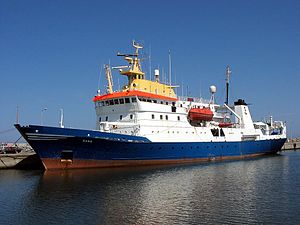
The 78-metre (256-foot) Danish fisheries research vessel Dana.
Fisheries science is the academic discipline of managing and understanding fisheries. It is a multidisciplinary science, which draws on the disciplines of limnology, oceanography, freshwater biology, marine biology, conservation, ecology, population dynamics, economics and management to attempt to provide an integrated picture of fisheries. In some cases new disciplines have emerged, as in the case of bioeconomics and fisheries law.
Fisheries science is typically taught in a university setting, and can be the focus of an undergraduate, master's or Ph.D. program. Some universities offer fully integrated programs in fisheries science. Read more... A radiologist interpreting magnetic resonance imaging.
A radiologist interpreting magnetic resonance imaging.
Radiology is the medical specialty that uses medical imaging to diagnose and treat diseases within the body.
A variety of imaging techniques such as X-ray radiography, ultrasound, computed tomography (CT), nuclear medicine including positron emission tomography (PET), and magnetic resonance imaging (MRI) are used to diagnose or treat diseases. Interventional radiology is the performance of (usually minimally invasive) medical procedures with the guidance of imaging technologies. Read more...- Architecture – the process and the product of designing and constructing buildings. Architectural works with a certain indefinable combination of design quality and external circumstances may become cultural symbols and / or be considered works of art. Read more...
- The following outline is provided as an overview of and guide to forestry:
Forestry – science and craft of creating, managing, using, conserving, and repairing forests and associated resources to meet desired goals, needs, and values for human and environment benefits. Forestry is practiced in plantations and natural stands. Forestry accommodates a broad range of concerns, through what is known as multiple-use management, striving for sustainability in the provision of timber, fuel wood, wildlife habitat, natural water quality management, recreation, landscape and community protection, employment, aesthetically appealing landscapes, biodiversity management, watershed management, erosion control, and preserving forests as 'sinks' for atmospheric carbon dioxide. Read more...
Ophthalmology (/ˌɒfθælˈmɒlədʒi/, /ˌɒpθælˈmɒlədʒi/ or /ˌɒpθəˈmɒlədʒi/) is a branch of medicine and surgery (both methods are used) that deals with the diagnosis and treatment of eye disorders. An ophthalmologist is a specialist in Ophthalmology. Their credentials include a doctorate degree in medicine, followed by an additional four years of Ophthalmology residency training. They may or may not receive residency training in internal medicine, pediatrics, or general surgery before the ophthalmology residency. Additional training may be sought through a fellowship in a particular specialty of eye pathology. Ophthalmologists are allowed to use medications to treat eye diseases, implement laser therapy, and perform surgery when needed. Ophthalmologists may participate in academic research on the diagnosis and treatment for eye disorders. Read more...- The following outline is provided as an overview of and topical guide to chemical engineering:
Chemical engineering – deals with the application of physical science (e.g., chemistry and physics), and life sciences (e.g., biology, microbiology and biochemistry) with mathematics and economics, to the process of converting raw materials or chemicals into more useful or valuable forms. In addition to producing useful materials, modern chemical engineering is also concerned with pioneering valuable new materials and techniques – such as nanotechnology, fuel cells and biomedical engineering. Read more... - The following outline is provided as an overview of and topical guide to military science:
Military science – study of the technique, psychology, practice and other phenomena which constitute war and armed conflict. It strives to be a scientific system that if properly employed, will greatly enhance the practitioner's ability to prevail in an armed conflict with any adversary. To this end, it is unconcerned whether that adversary is an opposing military force, guerrillas or other irregulars, or any adversary who knows of or utilizes military science in response. Read more...
Pediatrics (also spelled paediatrics or pædiatrics) is the branch of medicine that involves the medical care of infants, children, and adolescents. The American Academy of Pediatrics recommends people be under pediatric care up to the age of 21. A medical doctor who specializes in this area is known as a pediatrician, or paediatrician. The word pediatrics and its cognates mean "healer of children"; they derive from two Greek words: παῖς (pais "child") and ἰατρός (iatros "doctor, healer"). Pediatricians work both in hospitals, particularly those working in its subspecialties such as neonatology, and as primary care physicians. Read more...- Microtechnology is technology with features near one micrometre (one millionth of a metre, or 10−6 metre, or 1μm).
Around 1970, scientists learned that by arraying large numbers of microscopic transistors on a single chip, microelectronic circuits could be built that dramatically improved performance, functionality, and reliability, all while reducing cost and increasing volume. This development led to the Information Revolution. Read more...
Endocrinology (from endocrine + -ology) is a branch of biology and medicine dealing with the endocrine system, its diseases, and its specific secretions known as hormones. It is also concerned with the integration of developmental events proliferation, growth, and differentiation, and the psychological or behavioral activities of metabolism, growth and development, tissue function, sleep, digestion, respiration, excretion, mood, stress, lactation, movement, reproduction, and sensory perception caused by hormones. Specializations include behavioral endocrinology and comparative endocrinology.
The endocrine system consists of several glands, all in different parts of the body, that secrete hormones directly into the blood rather than into a duct system. Hormones have many different functions and modes of action; one hormone may have several effects on different target organs, and, conversely, one target organ may be affected by more than one hormone. Read more... NASA engineers, seen here in mission control during Apollo 13, worked diligently to protect the lives of the astronauts on the mission.
NASA engineers, seen here in mission control during Apollo 13, worked diligently to protect the lives of the astronauts on the mission.
Aerospace engineering is the primary field of engineering concerned with the development of aircraft and spacecraft. It has two major and overlapping branches: aeronautical engineering and astronautical engineering. Avionics engineering is similar, but deals with the electronics side of aerospace engineering.
Aeronautical engineering was the original term for the field. As flight technology advanced to include craft operating in outer space (astronautics), the broader term "aerospace engineering" has come into common use. Aerospace engineering, particularly the astronautics branch is often colloquially referred to as "rocket science". Read more...- Fungiculture is the process of producing food, medicine, and other products by the cultivation of mushrooms and other fungi. A mushroom farm is in the business of growing fungi.
The word is also commonly used to refer to the practice of cultivating fungi by leafcutter ants, termites, ambrosia beetles, and marsh periwinkles. Read more...
Mariculture is a specialized branch of aquaculture involving the cultivation of marine organisms for food and other products in the open ocean, an enclosed section of the ocean, or in tanks, ponds or raceways which are filled with seawater. An example of the latter is the farming of marine fish, including finfish and shellfish like prawns, or oysters and seaweed in saltwater ponds. Non-food products produced by mariculture include: fish meal, nutrient agar, jewellery (e.g. cultured pearls), and cosmetics. Read more...- Psychiatry is the medical specialty devoted to the diagnosis, prevention and treatment of mental disorders. These include various maladaptations related to mood, behaviour, cognition, and perceptions. See glossary of psychiatry.
Initial psychiatric assessment of a person typically begins with a case history and mental status examination. Physical examinations and psychological tests may be conducted. On occasion, neuroimaging or other neurophysiological techniques are used. Mental disorders are often diagnosed in accordance with clinical concepts listed in diagnostic manuals such as the International Classification of Diseases (ICD), edited and used by the World Health Organization (WHO) and the widely used Diagnostic and Statistical Manual of Mental Disorders (DSM), published by the American Psychiatric Association (APA). The fifth edition of the DSM (DSM-5) was published in 2013 which re-organized the larger categories of various diseases and expanded upon the previous edition to include information/insights that are consistent with current research. Read more... - Environmental science is an interdisciplinary academic field that integrates physical, biological and information sciences (including ecology, biology, physics, chemistry, plant science, zoology, mineralogy, oceanography, limnology, soil science, geology and physical geography (geodesy), and atmospheric science) to the study of the environment, and the solution of environmental problems. Environmental science emerged from the fields of natural history and medicine during the Enlightenment. Today it provides an integrated, quantitative, and interdisciplinary approach to the study of environmental systems.
Related areas of study include environmental studies and environmental engineering. Environmental studies incorporates more of the social sciences for understanding human relationships, perceptions and policies towards the environment. Environmental engineering focuses on design and technology for improving environmental quality in every aspect. Read more...  Oil painting depicting Claude Bernard, the father of modern physiology, with his pupils
Oil painting depicting Claude Bernard, the father of modern physiology, with his pupils
Physiology (/ˌfɪziˈɒlədʒi/; from Ancient Greek φύσις (physis), meaning 'nature, origin', and -λογία (-logia), meaning 'study of') is the scientific study of the functions and mechanisms which work within a living system.
As a sub-discipline of biology, the focus of physiology is on how organisms, organ systems, organs, cells, and biomolecules carry out the chemical and physical functions that exist in a living system. Read more...
Subcategories
Glossaries
Recognized content
Featured articles
Good articles
Associated Wikimedia
The following Wikimedia Foundation sister projects provide more on this subject:
Wikibooks
Books
Commons
Media
Wikinews
News
Wikiquote
Quotations
Wikisource
Texts
Wikiversity
Learning resources
Wiktionary
Definitions
Wikidata
Database
- What are portals?
- List of portals
- ^ Chris Bergin (23 January 2019). "Blue Origin conducts New Shepard's 10th test flight". NASASpaceFlight.com. NASA. Retrieved 1 February 2019.
- ^ Eric Berger (23 January 2019). "New Shepard makes 10th launch as Blue Origin aims to fly humans late in 2019". Ars Technica. Retrieved 1 February 2019.

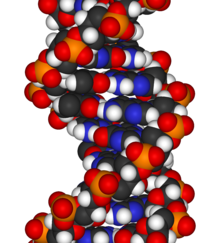




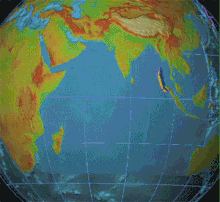


.jpg/220px-Artist%27s_impression_of_the_Milky_Way_(updated_-_annotated).jpg)

.jpg/275px-Pathologists_looking_into_microscopes_(1).jpg)

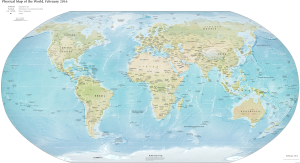
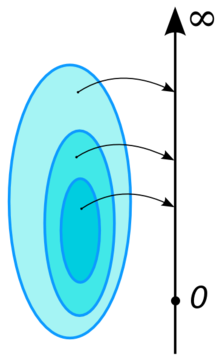




.jpg/220px-Loaded_centrifugal_governor_(New_Catechism_of_the_Steam_Engine%2C_1904).jpg)

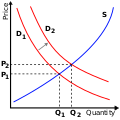












.jpg/88px-Science_Vol._1_(1880).jpg)
_Studies_consensus.jpg/120px-Cook_et_al._(2016)_Studies_consensus.jpg)













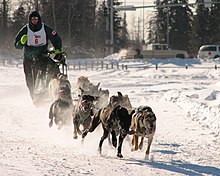

.png/350px-UN_Human_Development_Report_2007_(1).png)
_CBC.svg/220px-UN_Human_Development_Report_2007_(1)_CBC.svg.png)





_by_Emperor_Huizong.jpg/170px-Court_ladies_pounding_silk_from_a_painting_(捣练图)_by_Emperor_Huizong.jpg)



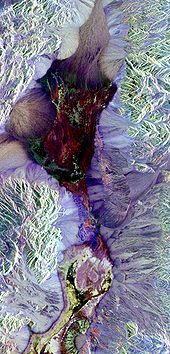

.jpg/220px-Babbage_Difference_Engine_(Being_utilised).jpg)
